
Meet Tom Stritikus
Coming off a transformational tenure at a small Colorado college, Oxy’s president-elect plans to hit the ground running In July
SPRING 2 024 Neighborhood Watch: New Venues, Old Faves Rethinking Theater and Performance Studies

Occidental College Bookstore oxybookstore.com
To order by phone: 323-259-2951
All major credit cards accepted
Volume 46, Number 2 oxy.edu/magazine
OCCIDENTAL COLLEGE
Harry J. Elam, Jr. President
Wendy F. Sternberg
Vice President for Academic Affairs and Dean of the College
Vivian Garay Santiago
Interim Vice President for Student Affairs and Dean of Students
Amos Himmelstein
Vice President & Chief Operating Officer
Suzanne LaCroix
Vice President for Institutional Advancement
Rod Leveque
Vice President for Marketing & Communications
Maricela L. Martinez
Vice President of Enrollment
James Uhrich
Vice President & Chief Information Officer
editorial staff
Dick Anderson
Editor
Marc Campos
College Photographer & Videographer
Jasmine Teran, Rachael Warecki
Contributing Writers
Gail (Schulman) Ginell ’79
Class Notes Editor
SanSoucie Design Design
DLS Group Printing
OCCIDENTAL MAGAZINE
Published quarterly by Occidental College
Main number: 323-259-2500
To contact Occidental magazine
By phone: 323-259-2679
By email: oxymag@oxy.edu
By mail: Occidental College
Office of Communications F-36
1600 Campus Road
Los Angeles CA 90041-3314
Letters and class notes submissions may be edited for length, content, and style.
Occidental College online
Homepage: oxy.edu
Facebook: facebook.com/occidental
Instagram: instagram.com/occidentalcollege
TikTok: occidentalcollege X: @occidental
Cover photo by Marc
Oxy Wear photo by Marc Campos
Campos
Megan: Unisex sweatshirt with Oswald face in beige and oxford.
Sizes S-XXL. $39.95
Marie: adidas Women’s Amplifier Tee with Occidental Tigers in medium gray heather. Sizes S-XL. $32.95
Megan Johnson ’19 Lead Stage Technician Performing Arts Facilities
Marie Scott Mawji ’01 Associate Production Manager Performing Arts Facilities
With Bruiser Woods in hand, sorority queen Elle Woods (Sabrina Sterns ’25) turns Harvard Law School norms upside down in her quest for love and justice in Legally Blonde: The Musical.



President Harry J. Elam, Jr. shares three insights into leadership that he will carry with him long after his departure from Occidental. Also: New books from Oxy alumni and faculty.
From the Quad Highlights from the inaugural season of Oxy Live! Also: Women’s basketball wraps its winningest campaign in more than a decade— and better things may be yet to come.
Talk Spearheaded by Andrea Cova-Bernal ’08, below right, two Oxy professors collaborate with two dozen first-years on an oral history of OCLAA.

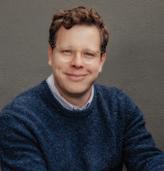
Page In A Paradise of Small Houses, city planner and architecture buff Max Podemski ’06 traces the DNA of urban housing.
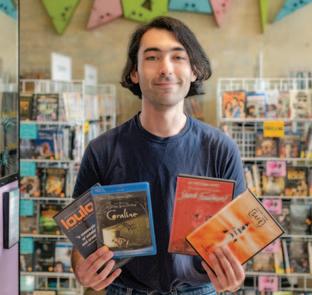
8
Introducing Tom Stritikus
Occidental’s president-elect is a firstgeneration college graduate and a firm believer in the transformative power of a liberal arts education.
12
You’re the Inspiration
Professors Maryanne Horowitz, Roberta Pollock, and Beth Braker have encouraged generations of their students to pursue fulfilling careers. They may be saying goodbye to Oxy, but they’re not the retiring type.
20
Resetting the Stage
As its second century dawns, Oxy’s Theater and Performance Studies Department remixes the curriculum with a blend of theory and practice.
26
Theater of the Absurd
Occidental Children’s Theater has delighted audiences of all ages for 29 seasons—but what’s next after Cinderalice in Wonderland? We went to Jamie Angell for answers
27
Neighborhood Watch
Eagle Rock and Highland Park have become magnets for new businesses, including the resurrected Eagle Theatre (the new home of Vidiots). What’s changed—and what’s still in fashion?
PHOTO CREDITS: Marc Campos All photos except as noted | Andrea Cova-Bernal ’08 Oxy Talk | Max Podemski ’06 Last Page
Features Departments 2 First Word
4
10
27 34
64
SPRING 2024
Oxy
Last
36 Tigerwire Class notes for all years.
» FROM PRESIDENT ELAM
Three Insights From the Last Four Years
Just over four years ago, in February 2020, I received a life-changing phone call: Stephen Rountree ’71, who was then chair of the Board of Trustees, shared that the trustees had just selected me to be Occidental College’s 16th president.
I was so excited to accept. I knew that this was a campus where I wanted to be. I believed my background in academic scholarship and leadership of the undergraduate program at Stanford University had prepared me for guiding this vibrant and distinctive liberal arts college in Los Angeles. And still, since that first year—when I came to a campus nearly silent against the turbulent backdrop of the pandemic—I have so often been amazed, delighted, and captivated by what I have found in this community.
In many ways, being president of Occidental is like being the mayor of a small town. Everyone knows who you are. In addition, there is a genuine investment in leadership here—a desire for dialogue, recognition, and understanding—that is one of the College’s many strengths. Everyone here—students, alumni, faculty, staff— has taken pride of ownership in our progress, and so we move forward together.
And together, we have navigated the challenges of the COVID-19 pandemic and the return to campus. We have completed the largest comprehensive campaign in our history. And we have launched the Occidental Promise, a strategic plan through 2030. I am thrilled at what we have accomplished and believe in the specialness of this place and all that it is and has the potential to be.
We are a small town, yet vast in vision, in the range of ideas we explore, in the diversity of viewpoints. Harnessing the many competing ideas and priorities of this community has been a most rewarding challenge, and has manifested and shaped insights into leadership that I will carry with me long after I depart at the end of this academic year. I share some of them here in hopes that you, too, might find them useful:
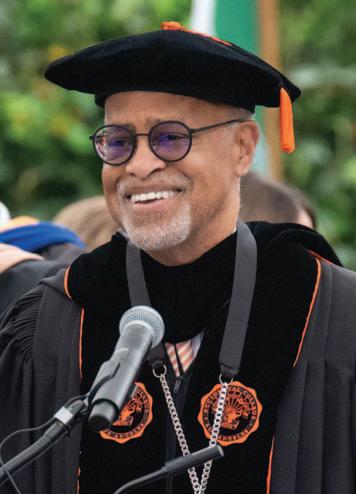
First, the importance of transparency. From the very beginning, during the height of the COVID-19 pandemic, I quickly understood that our community needed not only to know the decisions I made on behalf of the College but also their rationale. This commitment to transparency has continued throughout my term, from our return to campus in fall 2021 to current student activism around geopolitical issues. Transparency requires vigilance and consistent effort, a lantern’s flame that must be tended. It can be difficult to maintain, but it is essential for building trust, and should not be taken for granted even in a close-knit community like ours.
Second, the importance of coalition building. As leaders, our first question must always be: Who is at the table? Critical decisions require input from key stakeholders, students, staff, faculty, and senior leadership in order to achieve a collaborative vision. It has been especially important for me to hear students’ voices. Students advocate for change because college is a
space where change can actually happen. The opportunity to listen to and work with students is one of the reasons I came to Occidental, and I have found our students’ commitment to a holistic, pluralistic academic experience to be one of the great joys of my time here.
Finally, empathy—a genuine curiosity about others’ experiences coupled with compassion—is an essential and grounding principle for me. It is especially important in the face of disagreement and criticism. Just after my final interview for the presidency four years ago, I asked two students on the search committee what they appreciated most about Occidental. “The activism,” they quickly replied. One of the students congratulated me by telling me, “We like you, but if you mess up, we’ll protest you.” They remained true to their word, and learning not to take criticism personally has been among my most important and difficult lessons. But as challenging as it is to remain open in the face of sharp critiques, such engagement is vital to understanding where students are coming from. And when students feel that we are actively listening to their requests, when we convey that we care deeply about what matters to them, we can open space for trust to grow, for productive dialogue, for understanding if not agreement, and for realizing shared values that are fundamental to the institution.
Thank you for inviting me into this community. I am greatly appreciative of all your support. It has been a privilege and honor to serve as president of Occidental, and I am grateful for every moment. I know that this institution has a very bright future ahead and will remain with me forever.
Io Triumphe!

2 OCCIDENTAL MAGAZINE SPRING 2024
FIRST WORD
Harry J. Elam, Jr.
President Elam at the podium on May 19.
Photo by Marc Campos
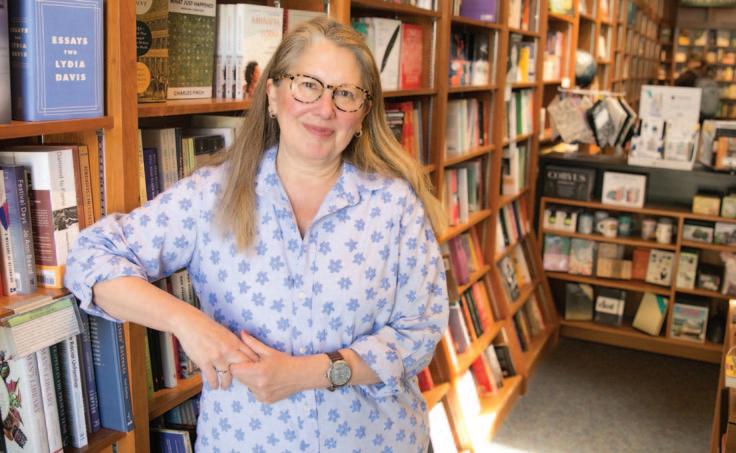
our thinking, reflections on the intersection of developmental neuroscience and developmental science, and the 1997 “I Am Your Child” campaign that created a national awareness of early brain development and its importance—and led to many public policy initia tives, including California’s Proposition 10 (First 5 California). A magna cum laude graduate of Occidental as a psychology major, Thompson recently retired from UC Davis as distinguished professor emeritus of psychology.

Real Life and Other Fictions, by Susan Coll ’81 (Harper Muse). Cassie Klein is a 50something aspiring novelist waiting for her literary dreams to take flight—only now her plot points aren’t lining up. Orphaned at age 2, Cassie has long wondered why her D.C.-based parents were driving on the Silver Bridge in West Virginia when it collapsed on Dec. 15, 1967, taking their lives. Her search for answers prompted a failed career in journalism, and Cassie is teaching at a community college when she learns that her once-doting husband, Richard, is cheating on her.
Cassie has had enough. Scooping up her 8-month old rescue Lab, Luna, she embarks on a road trip, heavy on impulse and light on planning, to answer the question: What really happened to her parents in 1967? In the process, she encounters an enigmatic cryptozoologist who helps her in the quest to discover her past, and she looks for answers regarding curious sightings of a creature known as the Mothman in the months before her parents died. As the line between real life and fiction blurs, Cassie grapples with the nature of stories, myths, and who gets to write the endings. Real Life and Other Fictions is the seventh novel by Coll (Bookish People), who lives in Washington, D.C.

Brain Development Revolution: Science, the Media, and Public Policy, by Ross Thompson ’76 (Cambridge University Press). The science of human development informs our thinking about children and their development. In his book, Thompson seeks to answer the question of how and why early brain development is such a predominant lens through which we perceive young children. Answering this question draws him in many directions: a discussion of why neuroscience has such a compelling effect on

The Only Way Out: The Racial and Sexual Performance of Escape, by Katherine Brewer Ball ’01 (Duke University Press). America has long held a fascination with the escape story as a means of exploring our conceptions of freedom and constraint. Such stories become mythic in their episodic iterations, revealing the fantasies and desires of society, storyteller, and listener. While white escape narratives have typically been laden with Enlightenment fantasies of redemption where freedom is available to any individual willing to seize it, Brewer Ball examines a range of works—from 19th-century American literature to contemporary art and writing—to explore how Black and queer escape offer forms of radical possibility. Brewer Ball is assistant professor of theater at Wesleyan University.
Exquisite Dreams: The Art and Life of Dorothea Tanning, by Amy Lyford (Reaktion Books). Dorothea Tanning (1910-2012) has for decades been known primarily as a Surrealist, but Exquisite Dreams shows how the work of this passionate, dynamic, and voraciously curious artist is impossible to categorize. Tanning’s lesser-known but equally powerful sculptures, abstract paintings, and films are explored here, and her writings, biography, and art are examined in the context of 20th-century developments in advertising, fashion, popular culture, and art in New York and Paris. Using new archival sources and analyses of Tanning’s work in a variety of media, Amy Lyford broadens our understanding of the artist and illuminates her stunning diversity and achievement. This richly illustrated book is an important contribution to the history of women artists, gender, and sexuality studies, as well as the history of Surrealism. Lyford is the Arthur G. Coons Professor in the History of Ideas at Occidental College.
 The
The
MIXED MEDIA
SPRING 2024 OCCIDENTAL MAGAZINE 3
Photo by Dennis Drenner
Susan Keselenko Coll ’81, photographed at Politics and Prose in Washington, D.C.

An Evening of Eavesdropping
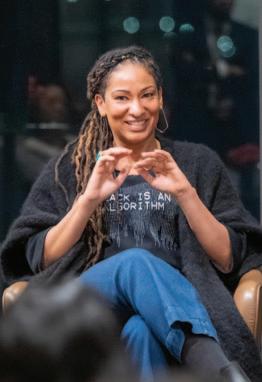
sat down for a conversation with cultural interlocutor Paul Holdengräber on November 20, 2023, at the Ford Foundation Center for Social Justice in New York City. below: The inaugural event of Oxy Live! last October featured writer,

Oxy Live!—the College’s new conversation series featuring a world-class lineup of artists—engages audiences in dialogues about culture and society

“The arts provide us with a special window on the truth,” President Harry J. Elam, Jr. said last October to an enthusiastic Thorne Hall audience on the opening night of Oxy Live!—a new conversation series highlighting a diverse lineup of cultural luminaries at the forefront of their fields. “In and through the arts, we gain insight into the changing human experience in all its dimensions. I know I am not alone in this room in believing that the arts truly have the power to change the world.”
One speaker at a time, the series more than lived up to its potential over five nights of conversation during the fall and spring semesters. Beginning with internationally celebrated writer, artist, and nonbinary activist Alok in October—more on them to follow— the lineup continued with thought-provoking
writer and progressive icon Rebecca Solnit, sociologist Ruha Benjamin, and visual artist Julie Mehretu—culminating in an illuminating (and at times hilarious) conversation with Laurie Anderson in April. The multimedia legend shared her thoughts about artificial intelligence, the virtues of optimism, the pleasures of eavesdropping, and much more to a near-capacity crowd in Thorne Hall.
Conceived by Meldia Yesayan, director of Oxy Arts, the College’s community-based arts hub, the series got off the ground thanks in large part to the support of Occidental trustee Lisa Coscino ’85, who has made a multiyear commitment to Oxy Live!
“When I was first approached by Meldia about supporting the program, I was immediately drawn to the mission of bringing
THE QUAD
FROM
left: Sociologist Ruha Benjamin
artist, and nonbinary activist Alok.
4 OCCIDENTAL MAGAZINE SPRING 2024
Meldia Yesayan, director of Oxy Arts and the creative force behind the Oxy Live! series, welcomes attendees to the Rebecca Solnit conversation in Thorne Hall last November.
Laurie Anderson had a near-capacity Thorne Hall crowd in the palm of her hand on April 10.

thought-provoking conversations and cultural experiences to campus,” Coscino said in her remarks on April 10. “The idea of creating a space where ideas could flourish and minds could expand resonated deeply within me.”
The common bond among these conversations is Paul Holdengräber, a self-described “curator of public curiosity” and “a consummate interviewer and unparalleled artistic interlocutor,” in the words of Coscino. In 2005, Holdengräber founded and directed the New York Public Library’s esteemed Live From the NYPL cultural series, where he hosted and interviewed over 600 iconic figures, and more recently served as founding executive director of Onassis Los Angeles (OLA).
While an Oxy Live! conversation is best experienced in totality—and for those who cannot attend events in person, all but the Ruha Benjamin conversation can be viewed on Oxy Arts’ YouTube page—here’s a taste
To open his conversation with Alok, Holdengräber read aloud “a poem that came to my mind when I was thinking about you and discovering who you might be”—“The Danger of Wisdom” by American poet Jack Gilbert (published in 2009).
We learn to live without passion, to be reasonable. We go hungry amid the giant granaries this world is. We store up plenty for when we are old and mild. It is our strength that deprives us. Like Keats listening to the doctor who said the best thing for tuberculosis was to eat only one slice of bread and a fragment of fish each day. Keats starved himself to death because he yearned so desperately to feast on Fanny Brawne. Emerson and his wife decided to make love sparingly in order to accumulate his passion. We are taught to be moderate. To live intelligently.
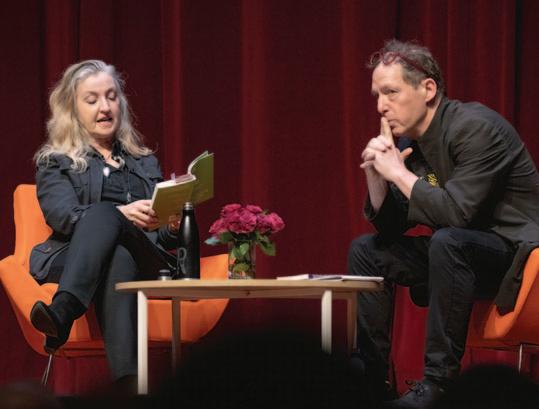
“I am wondering how this poem resonates with you,” Holdengräber said. “There are reasons for me to read it to you quite precisely. I’ll say a little bit about it, but I’d like for you to say something about it before I do.”
“No resonance whatsoever—try again,” Alok replied to laughter. “Of course, I feel like I began so much of my creative work through the rubric of gender, and I would often be told that I looked ridiculous, and I would try to correct for that like it was a stain that I could not remove. Now, I’m legitimate. Now, I’m reasonable. Now, I’m valid. But then eventually you begin to wonder why you have to be legitimate in order to be worthy. And then you begin to wonder, why not be ridiculous? Isn’t there so much beauty in being ridiculous?
“So now I find myself quite ambivalent about gender and more invested in ridiculousness. I want silly solutions to serious problems. I want to be irreverent and foolish, ludicrous and far-fetched. When people call me naive and idealistic, I say, ‘Thank you. Who broke your heart?’ I find that the real grief is that everyone was wonderful once upon a time and then got told to be reasonable— and I find that profoundly unreasonable.”
“Too often the arts and artists are shunted into the back room as being frivolous and denigrated as serving merely entertainment,” Elam noted on opening night. “This series enters into this conversation determined to position art as not tangential but central to the debate and discussion of our future. It is fitting that this engagement with the arts takes place at Occidental, with its proximity to the arts industry in Los Angeles and its ongoing commitment to critical in-
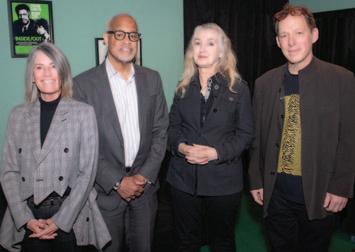
top left: Ethiopian-born painter Julie Mehretu, the top-selling African board artist of all time at auction, discussed her art on February 21. top right: Thought-provoking writer and progressive icon Rebecca Solnit reads from her 2023 book, Not Too Late: Changing the Climate Story From Despair to Possibility, as interviewer Paul Holdengräber listens intently. above: Oxy trustee and Oxy Live! benefactor Lisa Coscino ’85, President Harry J. Elam, Jr., Solnit, and Holdengräber in the green room behind the Thorne Hall stage.
quiry and to championing social justice. Starting with this discussion tonight, this series seeks to apply arts thinking as a way of providing insight, not into simply arts practice but into critical issues that we face today.”
In celebration of its milestone reunion, the Class of 1974 has established an Oxy Live! Speaker Series Fund as its class gift, with a goal of raising $350,000 to help fund the program over the next five years. Les Zendle ’74 has created a matching gift challenge of $65,000 to support the effort.
Oxy Live! returns this fall with opening speaker Tavares Strachan, a Bahamian-born conceptual artist whose 2018 sculpture The Encyclopedia of Invisibility will be on display as the centerpiece of Invisibility: Powers and Perils at Oxy Arts (in association with Getty’s PST Art) beginning in September.
We can’t wait for the conversation.
SPRING 2024 OCCIDENTAL MAGAZINE 5
FROM THE QUAD
Photo credits: Jane Kratochvil (Benjamin), Sarahi Apaez (Mehretu), and Marc Campos (all others)

Bringing the Heat
Playing through
injuries and fatigue, in
front of opposing crowds, Oxy’s ‘relentless’ women’s hoops team wins its way into the NCAA Tournament
Speaking to The Occidental newspaper after her first game back in action last November, Toni Thompson ’24—the high-scoring 5'9" guard who missed the entire 2022-23 women’s basketball season with a torn patellar tendon—all but prophesied the Tigers’ SCIAC fortunes for her senior year. “Based on our last game’s performance, I think it’s very feasible for us to end up in the top four [in the conference],” she said. “I know we have a fighting chance to win the championship and make it to the national [tournament], and I’m looking forward to it.”
Sixteen weeks later, Occidental punched its ticket to the NCAA Division III Women’s Basketball Tournament for only the third time in school history with a 66-58 victory over top-seeded Cal Lutheran on February 24 in the SCIAC Postseason Tournament championship. The third-seeded Tigers reached the finals by defeating second-seeded La Verne, 76-70, in another road contest on February 22.

Toni Thompson ’24 (shown in action against Chapman last November) led the SCIAC in scoring this season, averaging nearly 25 points per game.
“Our [preseason] goal was to just make it to the SCIAC Conference Tournament,” said First Team All-SCIAC center Ainsley Shelsta ’26, who averaged 13.7 points and 10 rebounds per game for the Tigers in her
Left: Occidental’s 66-58 victory over top-seeded Cal Lutheran on February 24 in the SCIAC Postseason Tournament championship game sent the Tigers to the NCAA Division III National Tournament. Below: “Coach Heat” huddles with her players in the NCAA opening-round game in Abilene, Texas, on March 1.


sophomore season. “Then somewhere along the way, that goal turned into winning the tournament and getting here. We put in all the work every single day … playing through injuries, playing through fatigue, playing through everything to get here.”
In their first trip to the NCAA Tournament in 13 years, Occidental ended its postseason run March 1 in Abilene, Texas, with a 65-53 loss to Hardin-Simmons University. Not counting two preseason exhibition wins, Oxy finished the season with a 20-6 record— the Tigers’ best showing since 2009-10.
“I’m super proud of my team and this season and how hard we’ve played, how competitive we’ve been,” Coach Anahit Aladzhanyan ’07 said in a postgame press conference in Abilene. “We fought ’til the end every game and though we’re disappointed by this outcome, I’m super proud of the Tigers.”
The Tigers previously won the SCIAC Postseason Tournament in 2009 and 2011, when Aladzhanyan was an assistant to thenHead Coach Heidi VanDerveer. Aladzhanyan—known to players and colleagues as “Coach Heat”—took over the program following VanDerveer’s departure in 2012.
Going back to the NCAA Tournament as a head coach felt “amazing,” says Aladzhanyan, who majored in psychology (with a minor in kinesiology) as a student at Oxy. “I am so proud of my team and staff and really wanted everyone to experience the NCAA Tournament, as it is such a special experience.”
6 OCCIDENTAL MAGAZINE SPRING 2024 FROM THE QUAD
Photo credits: Sam Leigh (Chapman), Logan Bury (SCIAC Tournament), and Scott Burkhalter (NCAA Tournament)

Following a 2022-23 campaign that saw the Tigers go 11-14 overall and finish 5-11 in conference play, Oxy improved to 11-5 in the SCIAC regular season, trailing co-champions Cal Lu and La Verne by two games.
Coach Heat attributes the Tigers’ turnaround “to the hard work, competitive drive, growth mindset, and toughness of our team,” she says. “I also attribute it to our health, and remaining healthy throughout the season.”
That begins with Thompson ’24, an AllSCIAC First Team selection this year and SCIAC Tournament MVP, who closed out her college career with 1,017 points—a remarkable output in a career that was limited to two seasons due to the pandemic and injury. Thompson, an economics/media arts and culture double major from Newbury Park, averaged 24.8 points as a senior, scoring a season-high 42 points in the Tigers’ 85-81 victory over Cal Lu on January 3. She led the conference in scoring and was the fifth-leading scorer in all of Division III this year.
For Thompson and fellow seniors Amaia McCoy and Gabriela Etopio, “Going from dead last [in the conference their sophomore season] to making the NCAA Tournament is a huge deal, not just for us but for the school in general,” she said after the game. “I could not be prouder of my teammates.”
Looking ahead to next season, the Tigers will return a playoff-tested group of players including rising juniors Shelsta, Paige Yasukochi, Dara Tokeshi, and Dominique Cabading. “Having that core group back, my hope is that we keep climbing,” said Aladzhanyan. (She and her assistants—Isaiah Gatewood-Flowers, Alma Garcia ’81, and Lashell Swann—were named SCIAC Coaching Staff of the Year in women’s basketball.)
Regardless of what the future may bring, this year’s Oxy squad won’t soon be forgotten. “One of the words that’s on the board every game is ‘relentless,’ and I think they embody that,’ Coach Heat said of her players. “We’re going to give it our all, and they show it every possession on the floor.”—dick anderson
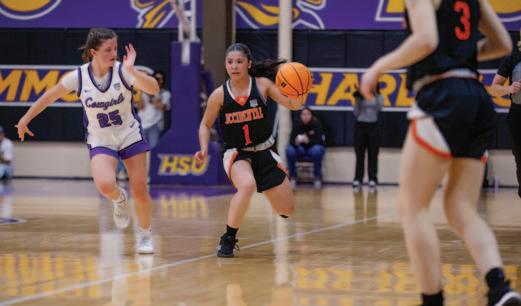
Despite playing more than 1,250 miles from home in front of a rowdy Cowgirls home crowd, the Tigers made some noise of their own in the Mabee Athletic Complex on March 1, as a small but vocal contingent of fans made the trip to Abilene to cheer on Oxy. 1. Dara Tokeshi ’26, a psychology major from Torrance. 2. Dominique Cabading ’26, a biology major from San Francisco.

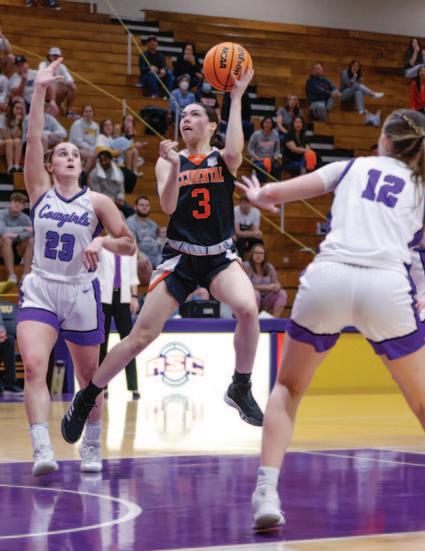

5.
FROM THE QUAD 1
2
3 4 5
SPRING 2024 OCCIDENTAL MAGAZINE 7
3. Thompson, an economics/media arts and culture double major from Newbury Park. 4. Gabriela Etopio ’24, an urban and environmental policy major from Las Vegas.
Paige Yasukochi ’24, a biology major from La Palma.
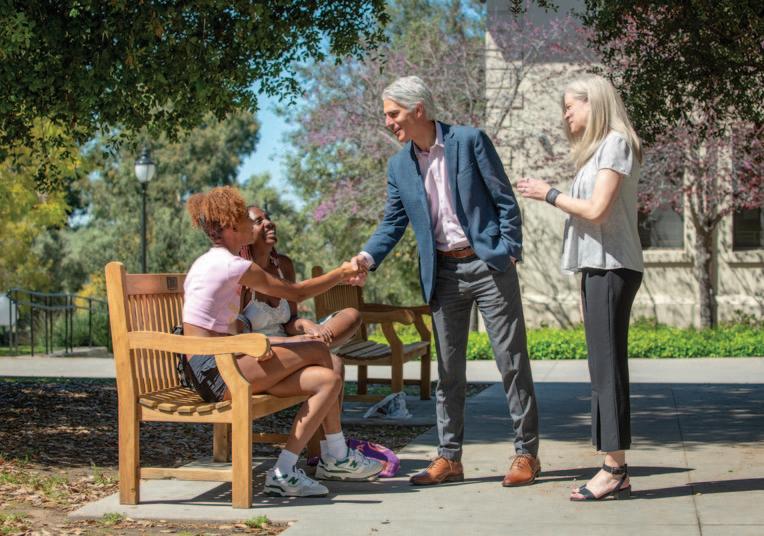
INTRODUCING
Tom Stritikus
Occidental ’s president-elect is a first-generation college graduate and a firm believer in the transformative power of a liberal arts education
By DICK ANDERSON Photos by MARC CAMPOS
N FEBRUARY 24, during a matinee performance of Occidental’s New Works Festival, an unidentified visitor snuck into Keck Theater. “It was really hard for me not to say hi to everybody because I like to say hi to everybody,” Tom Stritikus admits. The play he watched was A Slight Disruption, by Gianna Nguyen ’26, an urban and environmental policy major and interdisciplinary writing minor from Huntington Beach.
“It was simply a great play, a story about immigrants—and it was written by a sophomore,” he marvels during a subsequent visit to campus in April—his first since being named Occidental’s 17th president. “And so many faculty were there in the audience.”
Community means a lot to Stritikus, 54, who has spent the last six years at the helm
of Fort Lewis College in Durango, Colorado. His success at the four-year public college— not only in doubling its endowment but also in working to reconcile the former Native American boarding school’s unsettling past —attracted the notice of Occidental’s Board of Trustees, which unanimously selected him to succeed President Harry J. Elam, Jr.
“Dr. Stritikus’ demonstrated success in creating an inclusive campus environment, bolstering experiential learning, accelerating financial support for the mission and programs at Fort Lewis, and being a consistent advocate for students, faculty, and academic excellence speak well to the alignment of his skills and experience with the needs and opportunities in the Occidental community,” says Board Chair Lisa Link P’18.
“Occidental coined the phrase ‘equity and excellence’ before it became common-
place in higher education,” Stritikus says. “As I started to look at the tremendous capacity of this faculty and their commitment to teaching and students, it blew me away.
“Another huge draw for me is the idea of connecting with L.A. and creating authentic, collaborative partnerships with community members that showcase the value of a liberal arts education,” he adds. “In meeting with the search committee, it was clear that this community wants to be something distinct. Oxy has the potential to be the nation’s most impactful liberal arts college.”
A native of Lincoln, Nebraska, Stritikus is a first-generation college graduate, the son of Greek immigrants. “My mother was a secretary at the University of Nebraska—she worked on the agricultural campus for her whole career—and my dad was a diesel machinist at the Burlington Northern Railroad,” he says. “My dad’s an incredibly smart guy— just so curious and thoughtful. He definitely instilled in us the value of an education.”
Fresh out of college with a degree in English in 1993, Stritikus took a job with Teach For America, which placed him at John Ruhrah, a K-8 “school of many nations” in an under-resourced district in Baltimore.
“I read Jonathan Kozol’s Savage Inequalities (1991) as an undergraduate and thought about the inequities in the education system,” says Stritikus, who taught elementary school for two years. Given his background, “I saw the value of what school meant for social mobility. The idea of working with immigrant students was an absolute passion of mine.”
Stritikus talked to the students about their interests, then went to a local library to load up on books to fuel them. “I have always been super keen on trying to figure out what students are interested in and letting them drive the conversation,” he says.
Although Stritikus and his future wife, Debbie Pfeifer, both attended the University of Nebraska, graduating two years apart, they didn’t meet until 2½ years after Tom graduated—at Duffy’s, a college bar in Lincoln. “I was living in Manhattan Beach, Tom was in Baltimore, and we were both home for Christmas,” Pfeifer says. “We had mutual friends who were talking to each other at Duffy’s, and so we started to talk. And we got along well and realized that we were going to see each other again at the same party on
8 OCCIDENTAL MAGAZINE SPRING 2024

“I’m just so excited to be part of this community,” says Stritikus, photographed during an April visit to Oxy. Opposite: Stritikus and wife Debbie Pfeifer greet students in the Academic
Quad.
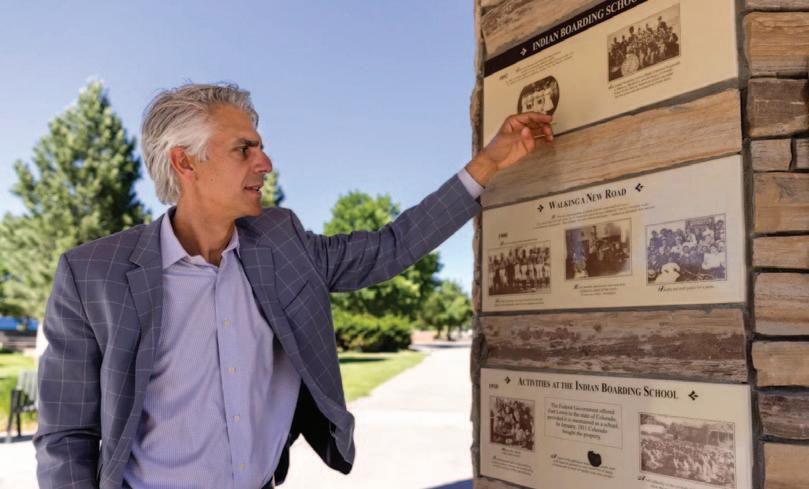
New Year’s Eve. After that, we kept in touch, and Tom invited me to visit him in Baltimore in February. And I said, ‘That sounds really awful. Why don’t you come to visit me in Manhattan Beach?’” She laughs. “And he did.”
Later that year, Stritikus enrolled in grad school at UC Berkeley, completing a combined M.A./Ph.D. program in 2000. For his doctoral thesis, he did research on the implications of California Proposition 227, which was passed by voters in 1998 and all but eliminated bilingual education in the California public schools. Stritikus studied the negative
institution building and thinking about how to leverage the great work that we do and connect with students in a different way.”
In his fifth year at UW, Stritikus was named associate dean for academic programs at the UW College of Education, and eventually dean of the college. “I was dean at a time when the larger narrative was that ed schools were not only contributing to outcomes for students of color but maybe potentially part of the problem,” he recalls. “So we tried at UW College of Ed to better connect with our community, and we ended
“Occidental coined the phrase ‘equity and excellence’ before it became commonplace in higher education.”
implications on students’ identity and ability to use their home language in the classroom in California’s Central Valley.
By the time Stritikus graduated, Pfeifer was living and working in Berkeley, where she was director of communications for PowerBar. When he started applying for academic jobs, Stritikus says, “Debbie and I were not married yet, but she got out a map and said, ‘OK, I’ll live in Washington, California, or Colorado.’ I didn’t want to be pen pals, so these were the places I could apply.” (The couple was married in 2003.)
Stritikus ultimately landed at the University of Washington as an associate professor in curriculum and instruction. As much as he loved teaching and research, he says, “I felt early on that my impact was going to be in
up getting quite a bit of funding from the Bill & Melinda Gates Foundation for some of the work that we were doing.”
In 2014, Stritikus was recruited to join the Gates Foundation innovation team, a position he held for four years. “It felt like an amazing opportunity to sit on the other side of the table to see what you could do with philanthropic capital,” he says.
As deputy director of education, “We did a lot of work in thinking about how to improve teacher education and how to work with both university partners and alternative certification partners,” he explains. “The greatest thing about working at the Gates Foundation was you’re thinking about how to change student outcomes across the United States; the worst part about it is that
left: Stritikus examines three panels that “whitewash” Fort Lewis College’s history as a federal Indian boarding school until 1910. below: The college held a ceremony to remove the erroneous panels on September 6, 2021.

you weren’t actually doing the work. I knew I wanted to get back into higher education and to become a college president.”
When Pfeifer learned that Fort Lewis was looking for a president, she quickly told her husband. After visiting the campus for the first round of interviews, Stritikus came away feeling that Fort Lewis was “a place that should be a national story and wasn’t. It was doing incredible work serving Native American students, but that wasn’t articulated in any kind of meaningful way. Durango [population 20,000] is a great community, and the college is so central to the town.
“Fort Lewis had great potential—it was just underperforming,” he continues. “They needed a leader who was super engaging, could come out and talk to everybody, and move fast—really fast—because they missed a lot of opportunities by moving too slow.”
During Stritikus’ tenure as president, Fort Lewis reversed declines in enrollment, delivered on the promise of free tuition for students with a family income under $70,000, and reached new fundraising highs. The college scored its largest gift to date in 2023, a $10.4 million pledge from Durango entrepreneurs and philanthropists Marc and Jane Katz to the School of Business Administration.
“That’s a transformational gift for a place our size,” Stritikus says. “We had an incredible advancement team and a great business school dean who led the effort. I think we have just gotten better at telling our story and creating a culture of philanthropy.”
Of all of his achievements at Fort Lewis, two items stand out. “In our strategic plan, the first plank was putting students at the center
10 OCCIDENTAL MAGAZINE SPRING 2024
Stritikus photo by Sharon Chischilly/The New York Times
of everything we do,” he says. “It became an identity for how we thought about things.”
Taking that mantra to heart, the college eliminated all designated parking spaces for all senior administrators—a nod to grousing about parking among the student population. (Consequently, Stritikus often had a 12-minute walk to his office from Stadium Lot 2.) “It’s a trivial example,” he admits, “but we tried to live it top to bottom, making decisions in the best interest of the students.”
Second was the reconciliation work done over several years to address Fort Lewis’ institutional history of Indigenous oppression and cultural genocide dating back to its origins as a federal Indian boarding school, forcibly removing children from their families and Indian tribes. The work culminated in a ceremony to remove three historically inaccurate panels from the college’s iconic Clocktower on Sept. 6, 2021—an event that was attended by nearly 1,000 members of the Durango community, including tribal elders of the Ute Mountain Ute Tribe, campus leaders, and Native American students.
“That was the most profound moment in my career,” Stritikus says. Fort Lewis trustee and Ute Tribe member Ernest House Jr., who spoke at the ceremony, “put it best: ‘You start this process and you’re not sure where it’s going to go.’ From a bill that we lobbied with our two tribes to investigate the Old Fort site [in Hesperus, Colorado— the college’s original home] for unmarked graves and not being afraid to address those questions, that was pretty amazing.”

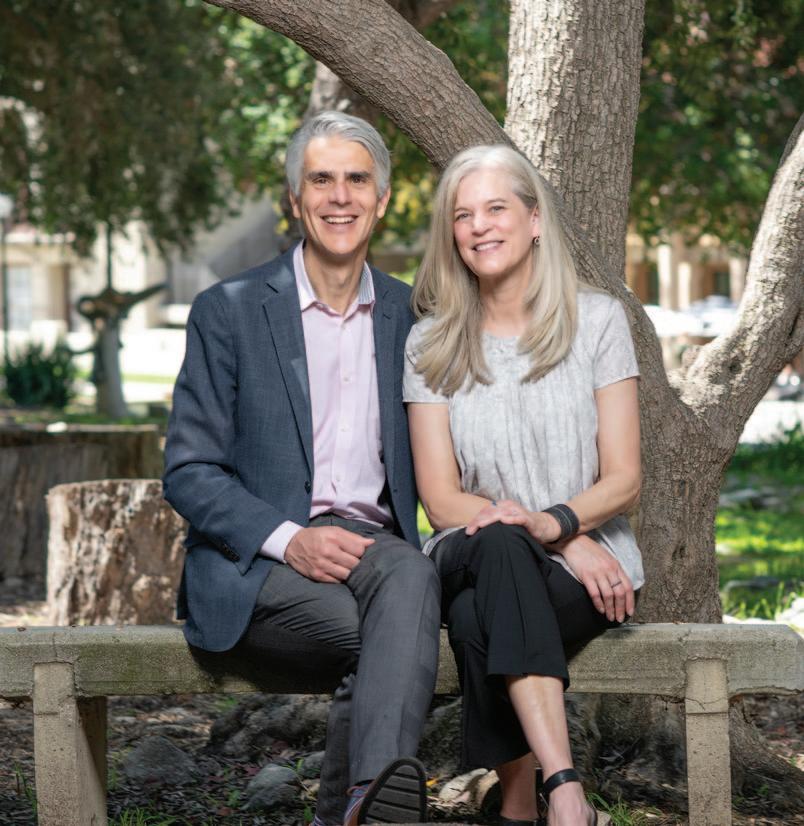
Shoot Me) are a presence every year, and the sixth annual festival is scheduled to take place June 25-30.
A Durango Post editorial published in April following the news of Stritikus’ decision to leave Fort Lewis celebrated his enduring contributions to the college. “His visions to do right by all students at FLC were comprehensive, his achievements will be long-lasting,” they wrote. Occidental “is fortunate to soon have Stritikus as president.”
For her own part, Pfeifer, a major theater enthusiast, is winding up her tenure as board chair of Durango PlayFest, an annual festival that brings together playwrights, actors, and directors for a week to showcase new works at staged readings in front of local audiences. Festival cofounders Dan Luria (The Wonder Years) and Wendy Malick (Shrinking, Just
While the couple will miss the proximity to the local ski resort and Durango’s “gigantic dog park,” Stritikus and Pfeifer consider themselves city people at heart. “I’ll miss that easy access to the outdoors, but you have skiing within an hour and a half of Oxy,” Pfeifer says. “And this campus is such an oasis. So it’s not going to be as much of an adjustment.”
Stritikus and Pfeifer are the parents of twin boys, both college sophomores—Leo at Dartmouth College, and Hays at the University of Richmond in Virginia. Both have expressed an interest in government and public policy and are “excited” about the move to Los Angeles, Pfeifer says. The fifth family member—and a frenemy to squirrels who cross his path—is Sky, their rescue dog from South Korea. A 9-year-old Jindo mix, “He’s fast and ferocious,” Stritikus says.
Having recently gone through the college search process with their own kids, “We were talking about how so many descriptions of liberal arts colleges on the East Coast sound
the same,” Stritikus says. “It’s hard to differentiate what school you’re talking about. There is no other institution quite like Occidental—a liberal arts college in the center of a world-class city.”
And then there are the College’s centuryold Mission Olive trees, which the couple swooned over. “I’m not a big ‘woo-woo’ person, but when I saw those olive trees, I thought, ‘This is incredible,’ ” Pfeifer says.
“My father goes to Greece every fall and harvests olives,” Stritikus adds. “We didn’t even know that Oxy makes olive oil.” (Olives harvested on campus last November were pressed locally into bottles of extra virgin olive oil.) “My dad will come out next fall to help with the harvest,” he promises.
Needless to say, these are interesting times to be a college president. What’s the biggest challenge Stritikus expects to face at the outset? “Getting to know the community and making sure I understand what makes them tick—what’s important to them, what they care about, what their values are,” he says. “I’m going to spend a lot of time doing that at as fast a pace as I can.” And we’ll do our best to keep up with him.
SPRING 2024 OCCIDENTAL MAGAZINE 11
Above: Stritikus and Pfeifer in the College’s Olive Grove. Left: Sky sinks his teeth into Occidental.
You’re the INSPIRATION
Professors Maryanne Horowitz, Roberta Pollock, and Beth Braker have encouraged generations of their students to pursue fulfilling careers.
They may be saying goodbye to Oxy, but they’re not the retiring type
Edited by DICK ANDERSON Photos by KEVIN BURKE

with Plato’s Republic and including visits to local Ithaca communes.
porary Political Issues.” In addition, I was team-teaching with my husband one of the first courses in the nation on “Computers and Society” for a second year at Cornell.
What brought you to Occidental? Under the “old boy” system, history department chairs would typically call up a professor to recommend a man when there was a job opening. But in 1972, the American Historical Association published a guide to jobs, and I had 12 interviews at a conference in New Orleans that December.
In preparing for these interviews, I created three courses—titled “Ancient Athens,” “Renaissance Florence,” and “Renaissance Intellectual history”—and a seminar titled “Methodology in the History of Ideas.” When interviewers asked me what I’d like to teach, I had written these up as college catalog listings, with only two or three sentences each.
Maryanne Horowitz
PROFESSOR OF HISTORY
Years at Oxy: 51
What was your first job after graduate school?
After I completed a Ph.D. in history with a minor in political philosophy at the University of Wisconsin in June 1970, I accompanied my husband, Ellis, to Cornell University, where I was hired by the Government Department for the 1970-71 academic year. I taught political theory sections, comparative government first-year seminars, and created a course titled “Quest for Utopia,” starting
Cornell was one of the first colleges in the country where women’s studies was emerging. I designed a syllabus on “Woman and Man in Western Thought” and started writing a feminist critique of “Aristotle and Woman” [published in Journal of the History of Biology in 1976] and a feminist reinterpretation of Biblical text [published as “The Image of God in Man—Is Woman Included?” in Harvard Theological Review in 1979].
In the fall of 1972, I had a full-time visiting assistant professorship at Ithaca College, teaching “Woman and Man in Western Thought,” “Quest for Utopia,” and “Contem-
Occidental College advertised an opening in European intellectual history to 1700, and I interviewed with three Oxy faculty in New Orleans: Cliff Kroeber, John Rodes, and Norm Cohen. When Professor Rodes called my hotel room after the interview to tell me that the History Department was asking me to come out to Los Angeles the following week, he could hear my baby daughter crying in the background.
When I was asked to interview at Occidental on such short notice, my husband, who was an assistant professor at Cornell, called up some universities in Los Angeles,
12 OCCIDENTAL MAGAZINE SPRING 2024
Horowitz in a 1978 photo. “During my early years at Oxy, we created the Collegium, and I learned so much reading all of the books recommended by faculty. It rounded out my liberal arts education.”
Photo by John Kruissink
Leading the Way: Horowitz at Oxy
1977-79, 1982-85: Chair, Women’s Studies Advisory Committee
1977-79: Chair, College Scholar Program Committee
1978-79: Coordinator, Collegium
1988-91: Chair, History Department
1993-2011: Title IX Officer
2016-17: Co-chair, Gender, Women & Sexuality Studies minor
looking to see if they might need his skills. I was offered the Oxy job in January 1973, and he accepted his post at USC that May. [Ellis continues to teach as professor of computer science and electrical engineering at USC.]
How many women were on the faculty in 1973? Not many, but I sought them out to create together a women’s studies program. I talked to Anne Howells, Annabelle Rea, and Jane Jaquette, and together we asked Marsha Kinder, who was tenured and the senior one, to be the chair. In my second year at Oxy, the catalog listed women’s studies courses. From 1977 to 1979 and 1982 to 1984, I chaired the Women’s Studies advisory committee.
The program was canceled by the administration in 2008, but with the help of faculty (especially Laura Hebert in diplomacy and world affairs) and students (especially Alanna Quan ’16, who is now an archivist at Oxy), we reestablished the minor as Women’s, Gender, and Sexuality Studies in 2016, which continues to this day.
The best years for women’s studies at Oxy were when a faculty search specified the additional role of chairing the minor. The field expands research opportunities: While on a sabbatical in 1979-80, I taught a graduate-level course on “Women of the Reformation” at Harvard Divinity School, and on a sabbatical in 2003-04, I was a visiting scholar at UCLA’s Center for the Study of Women.
Your best-known work is Seeds of Virtue and Knowledge [1999 winner of the Jacques Barzun Prize in Cultural History from the American Philosophical Society]. When did the idea that the mind is a garden come to you? My doctoral thesis and articles in Journal of the History of Philosophy (1971) and Studies in the Renaissance (1974) analyzed De la Sagesse (1601) by Pierre Charron, a priest during the French religious wars. Supporting the religious toleration document of the

Edict of Nantes (1598), Charron argued that the seeds of virtue are scattered in all humanity, and consequently Calvinists and Catholics could live peacefully together in France.
Working on my dissertation in the middle of the Vietnam War, I found appealing this uplifting notion about human nature and sought its origin. I went to a philosophy professor at the University of Wisconsin, Julius Weinberg, and he led me over to the Loeb Classical Library edition of Seneca That was the beginning of my quest for documenting in visuals as well as in texts medieval and Renaissance vegetative images,
Hebraic and neo-Platonic notions of internal trees rising to the Godhead, and the neo-Stoicism in 16th-century philosophers including Du Vair, Lipsius, Bodin, and Montaigne.
The epilogue to the book sums it up best. The introduction raises the question as to whether “seeds of virtue and knowledge” is an epistemology, a strategy, a paradigm, or a metaphor. It concludes with goal to cultivate in the human community a garden of beauty, truth, and goodness.
What are you working on right now? Years ago, Occidental’s commitment to a diverse student body inspired me to go look
SPRING 2024 OCCIDENTAL MAGAZINE 13
Horowitz photographed in her Swan Hall office in April, overlooking the Academic Quad from what she calls “Juliet’s balcony.”
for a topic featuring human diversity. And outside the Musée d’Orsay in Paris are six cast iron statues [commissioned for the World Expo in Paris in 1878] representing six continents—the female personifications of Europe, Africa, Asia, North America, South America, and Oceania.
One day in Special Collections, when I was showing my students the College’s rare book containing these hand-colored Ortelius maps [Theatrum Orbis Terrarum], I realized the title page must have inspired those 19thcentury sculptures in Paris. That inspired me to gather a group of scholars to write a book on the personifications of the continents.
For the book Bodies and Maps: Early Modern Personifications of the Continents [published in 2021 by Brill Press], I introduced rival interpretations of the continent personifications—hierarchy, Christianity, ethnography, human dignity, and racism—as well analyzing the rival poems by which Ortelius introduced his Latin, Italian, and French editions. I also traced the Renaissance costume book influences on four large tapestries of personifications of Africa, America, Asia, and Europe that are still decorating the New York Public Library Trustees Room, as far as I know.
Now we’re working on a second book, tentatively titled Controversial Monuments: Personifications of the Continents From the 18th Century to the Present, with my co-editor on Bodies and Maps, Louise Arizzoli, taking her turn as lead editor. My chapter focuses on some rare Jesuit pulpits located in churches in Belgium, portraying wood figures of Africa, Asia, America, and Europe. As an extended reader at the Getty Research Institute, I related the wood figures to the artwork of Rembrandt and Rubens and to images of Jesuit missions abroad, and analyzed these three-dimensional figures which forecast the ones now outside the Musée d’Orsay.
Here in Los Angeles, we are blessed with the libraries and resources of the neighboring institutions, including the Huntington, the Getty Center, and the Clark Library of UCLA. At the UCLA CMRS Center for Early Global Studies, where I am an associate faculty member, this academic year I focused on Japan in early modern times, a topic of a yearlong series of conferences at the Clark

Library; and I recently participated in a twoweek tour of Japan.
What’s the most surprising thing about your own career? Some people think that retirement implies that one’s career is coming to a close, but I don’t see it that way. I will continue to serve on the board of editors and board of directors of the Journal of the History of Ideas, the journal which helped me define my interests as an undergraduate at Pembroke College in Brown University.
I became a historian of ideas with the notion that nothing human is foreign to me. European intellectual history would be my base, but my curiosity went beyond that, particularly into visual representation. My boldest innovation as editor-in-chief of the New Dictionary of the History of Ideas in 2005 was that the six volumes are both global and visual in presentation.
How did you and your husband manage to balance two careers with raising a family? Ellis and I raised three kids together, all of whom independently developed managerial and creative skills. Daughter Pipi Diamond is a pet and family photographer in the San Francisco Bay Area. Sons Edward and Ira Horowitz operate their own businesses in Calabasas and Beverly Hills, respectively. Ellis and I enjoy our five grandchildren, ages 13 to 5, and in April our family celebrated the bar mitzvah of the eldest grandchild. I would say we’ve compatibly made a life for ourselves in this city. A scientist might say we solved the “two-body problem.”
Anything else you’d like to touch on? I’m happy to correspond with former students in the future. I have a little bit more time now.
by
Diana Culp Bork ’79: I was among Maryanne Cline Horowitz’s earliest students at Oxy. She arrived in the fall of 1973. I arrived two years later, an unformed product of the Southern California public schools. Being a first-generation college student, I had little idea what I wanted out of my years at Occidental, what I wanted to study or what I wanted to do or be. Dr. Horowitz saw something in me that no one else did.
I gravitated to the humanities and over time wound up double majoring in psychology and history. I took Dr. Horowitz’s packed seminar in History of Ideas. I didn’t have a clue how to properly research or write a paper; Dr. Horowitz sent me off to Clark Memorial Library at UCLA to work with original manuscripts and 17th-century texts. And I started writing. And writing. And writing.
When Dr. Horowitz chaired the College Scholar Program, she asked me to present a thesis on the impact of natural law thought on slavery in Greco-Roman culture. Then came a paper on women’s rights in GrecoRoman law as developed from Draco’s Code, through the Codex Theodosianus and then the Corpus Juris Civilis. (Don’t ask!)
In my senior year, Dr. Horowitz suggested I apply for the Rhodes and Marshall scholarships. I did surprisingly well in both competitions, making regionals for both, but was not selected. Nevertheless, over lunch in the Cooler, she urged me on, and I was accepted at five top law schools, including Harvard Law, from which I graduated. Dr. Horowitz envisioned me there since she had eaten lunch there daily while working on her Harvard master of arts in teaching in social sciences.
14 OCCIDENTAL MAGAZINE SPRING 2024
As president of the Renaissance Conference of Southern California, Horowitz hosted a national conference of the Renaissance Society of America at Occidental and neighboring institutions in 1985.
Photo
John Kruissink
After I graduated from Occidental, Dr. Horowitz became “Maryanne,” at her insistence. Our friendship has endured ever since.
Maryanne visited me at Harvard when she had a sabbatical teaching assignment at Harvard Divinity School. I will never forget attending chapel together at Harvard Memorial Church, sitting in the choir stalls, while she gave the sermon on Ecclesiastes 3:1-8: “For everything there is a season.” Years later, Maryanne visited me in Washington, D.C., when I was practicing law. We shared lunches and dinners and wandered through Harvard University’s Dumbarton Oaks.
The love of learning, which Maryanne instilled in me, continued on in my life as a lawyer at the Department of Justice and then as deputy general counsel at the U.S. Department of Education. To this day I study education issues in America (for fun!) but have many historical readings lying around the house in various stages of completion.
My daughter, Claire, met Maryanne in our home in McLean, Va. Maryanne mentored her in her desire to work in game design. Today, she’s a successful game analyst at ZeniMax, a division of Microsoft.
My son, Robert, followed in my footsteps, the ones that Maryanne had set in motion decades before. While at the University of Virginia, he spent a summer at Oxford, vowing to return there for graduate work. He did precisely that—and in Maryanne’s field: history of ideas and intellectual history.

Robert’s scholarly work focuses on legal history with a research concentration on the impact of Adam Smith on American law and jurisprudence. Upon completion of his M.Phil last year, he received the Fortescue Scholarship from the Canterbury Institute and is now working toward a doctor of philosophy at Oxford. He applies to law school this fall.
None of this would have happened had not Maryanne noticed that quiet girl in the back row in 1975. Thank you, Dr. Horowitz.
A summa cum laude graduate of Occidental and cum laude graduate of Harvard Law, Bork is senior vice president and general counsel of Bork Communication Group.
David Kimball ’17: I met Professor Horowitz during my first year at Occidental, when I enrolled in her Cultural Studies Program class on Renaissance Individuals. At that time, my interests were divided between history and biology, and I dreamed of attending medical school. Professor Horowitz not only recognized my enthusiasm for these subjects but encouraged me to pursue them. As my adviser, she helped me develop a schedule that accommodated my premed requirements and my history major.
Professor Horowitz was not just a mentor but a source of inspiration who encouraged me to explore my love for teaching and tutoring. During my senior year, we devised an independent study class that gave me a unique opportunity to learn more about teaching. Previously, I had taken her Antiquity to 1700: Europe and the Middle East course, which I found very interesting. Professor Horowitz had always wanted to encourage greater participation in her class discussions, and she believed that my input would help achieve this goal. For my independent study, I was her teaching assistant for that class. My duties included participating in class discussions, coaching the group debate practices, researching and compiling a resource guide on the Crusades, and delivering a lecture on primary sources and the importance of critical reading.
In medical school, I used the teaching skills I had gained under Professor Horowitz’s guidance as a peer tutor and when I gave guest lectures for second-year pharmacology classes, where I discussed my clinical experiences with various drugs. I enjoyed sharing my insights while helping other medical students.

Professor Horowitz’s unwavering support and guidance were instrumental to my success at Occidental and beyond. Although medicine is now my career, I will always be a historian at heart. Her dedication and passion for teaching have left an indelible mark on me. I am forever grateful for the opportunities she has provided. I want to express my gratitude to Maryanne for everything she did for me.
Kimball is an internal medicine resident at Touro University Nevada.
Angélica Salas ’93: Maryanne Horowitz made me love history and taught me about the power we gain when we learn about our past. While I was a student at Occidental, I interned with her as she conducted research for her manuscript and observed how much attention to detail it takes to tell a historical story. I will always be grateful for her support of my successful application to the Ford Summer Internship Program.
As my mentor for this fellowship, Professor Horowitz gave me the opportunity to travel to Mexico and learn about Fray Bartolomé de las Casas and his defining role in the development of the ideas of human rights for indigenous peoples of the Americas. This work remains so relevant for me as I fight for human rights in the work I do as executive director of CHIRLA, the Coalition for Humane Immigrant Rights. Thank you, Professor Horowitz, for your dedication to me and to all the students who learned from you over your many years at Occidental.
Salas joined CHIRLA in 1995 and has been its executive director since 1999.
SPRING 2024 OCCIDENTAL MAGAZINE 15
Diana Culp Bork ’79 with her son, Robert Bork III, following his graduation from the University of Oxford with an M.Phil in history last year.
Photo by Robert H. Bork Jr.
Maryanne and Ellis Horowitz took a gondola ride within Las Vegas’ Venetian Resort in February.
Photo courtesy Maryanne Horowitz
Pollock (photographed in her lab in April) has a new email for anyone who wants to share notes or photos: drpollockretires@oxy.edu.
 Roberta Pollock
Roberta Pollock
PROFESSOR OF BIOLOGY
Years at Oxy: 35
What attracted you to Occidental? I had always assumed that I would be a faculty member at a research institution. After a personal tragedy, I wanted to help people more directly, and realized that teaching was very important to me. A friend suggested that a small liberal arts college would allow me to do both research and teaching—and it was a true lightbulb moment. I had two job offers at liberal arts colleges when I heard about the Oxy job from a faculty member at Haverford, Judy Owen, who told me I had to apply for it.
While I admit to having Southern California stereotypes (La La Land), I was happily surprised by the quality of the faculty and students at Oxy. And when I met with President Slaughter and we talked about Oxy divesting in South Africa, I was convinced that Oxy was where I should be. It also helped that I needed access to a flow cytometer (a very expensive instrument that analyzes and sorts cells using fluorescent labels), which I could get at both Caltech and UCLA.
What is your favorite course? Immunology. I developed this course during my first year at Oxy and taught it through this past
year. Personally, it gave me a chance to marvel at all the truly amazing changes that have occurred in the field. It is the course where I feel I help students the most.
It takes students the entire semester to learn the basic language of immunology. The immune system is very complex and our knowledge of how it works ranges from the organismal level to the most minute levels of gene expression and modification. The most important skill that students learn in this class is how to read, understand, and analyze very challenging scientific papers. I joke with my students that if they can figure out how to read an immunology paper, they can read any paper. Plus the skills they learn in the lab portion of the course help them in obtaining jobs. What will you miss about teaching? The students. Mentoring students and making a difference in their lives has been the highlight of my career. Introducing them to biology as an actively changing and exciting field has always been fun and rewarding, whether it’s getting students in Bio 130 (Introductory Cell and Molecular Biology) to read and present on current hot topics, or to analyze complicated immunology papers. Working with students facing challenges, whether personal or academic, and helping them get the support they need has been incredibly rewarding.
I will miss working with my research students the most. When they come into my lab,
they are initially overwhelmed by learning the techniques, but even more so by the immune system and our research model. Watching them grow and become independent scientists has been a highlight of my career.
You played a significant role in the College’s response to the pandemic. What did you take away from that experience? It was demanding but rewarding. For the first time in my life, my expertise was relevant and useful. I worked harder during the pandemic than at any other time in my life.
The highlight of that work was the Biology and Epidemiology of COVID-19 course that Dr. Kim Shriner ’80 and I developed together. The opportunity to teach a course on the pandemic as it was happening was unique. We discussed the structure, molecular biology, and molecular evolution of the SARSCoV-2 virus; different testing approaches; the pathophysiology and histology of COVID19 and the different manifestations in different populations; therapeutic and vaccine approaches; and the epidemiology of this disease. A major focus was the racial disparities and social inequities seen with this disease.
The outcome that I most value from this work were the friendships that I developed with Dr. Shriner, Dr. Magdalena Arias ’92, and Sara Semal [Oxy’s former senior director of student wellness and special adviser to the president on health and safety].
What are your plans after Oxy? I’m going to take three months where I can do whatever I feel like doing. I anticipate that most of my time will be spent sleeping (I have a lot of sleep to catch up on), reading, and working around my home. I’ll also ride my horse and my bike. Then I look forward to traveling— I already have several trips in mind. And I’ll be doing some volunteer work, most notably training my dog Taz as a therapy dog and taking him for visits to retirement facilities. As we’ve had to move my mother to an assisted living facility, I’ve been struck by how many seniors miss their dogs, and the comfort that Taz gives them.
Anything else you would like to add? My personal philosophy has been that I want to live my life so that on my deathbed I can look back over my life and feel good about what I have done—that I have made the world a better place—but also enjoy every day as though it was my last. Thank you to the Oxy community, especially my students, for an incredibly challenging, rewarding experience.
16 OCCIDENTAL MAGAZINE SPRING 2024
Phil Wong ’93: Coming into Oxy with a vague notion of wanting to study biology but not being sure what I wanted to do with it, I welcomed Roberta’s invitation to join her immunology laboratory to obtain undergraduate research experience to help me decide between medical school and graduate school. She was relatively new to the College then, so it was an absolute blast to be one of the pioneering members of her group to contribute to her research studying somatic hypermutation during antibody maturation in B cells.
Roberta was an excellent mentor in the lab, guiding us in our experiments and in becoming proficient with popular molecular biology methods that bring back memories to this day—restriction enzyme mapping, anyone? Working with the other members of her lab over the years resulted in lasting friendships as we spent significant time together at the bench to the tunes of Billy Joel in the background, or eating at local restaurants, or housesitting Roberta’s pets!
In her courses, Roberta was an engaging professor with a strong dedication to teaching and high standards. Her lectures on the immune system and how it works to defend our bodies against foreign microorganisms were what attracted me into the area. She anticipated excellence in all you did, which sometimes made for a bit of pressure in hoping to meet her expectations, but this was just a strong encouragement to excel!
Roberta was great about exposing her students to the most current scientific developments. I fondly remember jumping into her flashy red Porsche and driving up the California coastline to attend the Midwinter Conference of Immunologists. It was a lot to absorb for an undergrad, but Roberta was always there to clarify important concepts and give assurance that it would become easier to interpret complex data plots as they zip by.
From working with Roberta, I realized that I really enjoyed the research environment and went on to earn my Ph.D. in immunology. Subsequently, I worked on vaccines and therapies for inflammatory diseases in industry before taking a role at an academic medical center studying immune correlates of clinical outcomes in cancer patients receiving experimental immunotherapies. Roberta instilled in me a lifelong curiosity and passion for science for which I am forever grateful.
Wong directs the Immune Monitoring Facility at Memorial Sloan Kettering Cancer Center.
Christopher Hino ’15: I vividly recall feeling a mixture of curiosity and apprehension when I first set foot in the laboratory as a sophomore at Oxy. The labyrinth of glassware, complex machinery, and pipettes that surrounded me was daunting and seemingly insurmountable. However, my fears quickly melted away upon meeting Roberta Pollock, who warmly welcomed me to her lab, which she affectionately called “Team Coryne” (after the Corynebacterium she was researching). Roberta was a captivating presence— charismatic, kind-hearted, and passionate. It quickly became evident that her love for horses was only rivaled by her enthusiasm for teaching and immunology. My most cherished memories of Oxy are the adventures I shared with her and Team Coryne—weekly lab meetings, visits to the horse ranch, and road trips to Asilomar for conferences.
From guiding us through hundreds of ELISA experiments to providing constructive feedback on our summer grant proposals, she knew precisely how to get the best out of us. Her support never faltered even when our experiments sometimes failed to yield the expected results. It was here that she taught me an invaluable life lesson: Setbacks in life, just like in research, present golden opportunities for learning and growth.
Roberta’s selfless devotion to teaching and helping others has become a model for compassion that I continue to strive for in my career as a physician-scientist. I hope that one day I will be able to positively impact as many lives as she has during her time at Oxy.
Following in Pollock’s footsteps, Hino will be completing his medical training in allergy and immunology at Brigham and Women’s Hospital, Harvard Medical School.
Dina Kamel ’10: From the moment Luca Valle ’10 and I walked into Dr. Pollock’s office as sophomores to ask to join her research team, she took us under her wing and provided countless opportunities for personal and professional growth. She was integral to my development as a scientist and an adult.
Dr. Pollock didn’t limit our experience to the inside of the lab. In the course of doing research on the immune response to a bacterial infection in horses, we went on field trips to local stables, flew to UC Davis to meet with collaborators, and took a road trip to Monterey to attend and present our research findings at a prestigious scientific

meeting. Dr. Pollock shaped us into confident young scientists and ultimately into confident, patient-centered physicians.
After I graduated a semester early, Dr. Pollock hired me on as a lab assistant for that last semester; it meant so much to me to still have a home at Oxy and still feel like part of the community. In the years since, we have kept in touch. When I got married, she came to my wedding with her daughter to celebrate with us. After my husband and I had our first child, she sent him a sweet Christmas outfit. Back in January, Luca and I were meeting up for a walk with our babies and we asked Dr. Pollock to meet us for lunch. It felt like old times as we spoke about our families and careers. We told her then—as we want her to know now—how much she meant to us and how thankful we are for that day we walked into her office and she took us in.
Kamel is a clinical instructor at UCLA and is completing her endocrinology fellowship at USC.
Elise Burger ’11: Dr. Pollock is the most instrumental mentor I encountered at Oxy. She created a safe, wonderful place to ask questions and learn how to develop scientific hypotheses, and gave me the confidence to determine how to answer them.
She encouraged me to be the best version of myself and was always there for me both as a scientific mentor and as a personal cheerleader. Her passion for science and amazing teaching style inspired me to pursue not only a medical degree but also a Ph.D. in immunology. She was vital in supporting me through the application process, as no one in my family had ever attended grad school. I would not be the doctor or scientist that I am today without her mentorship. She has touched so many lives; we are all so lucky.
Burger is an assistant professor in the Department of Dermatology at the University of Utah.
SPRING 2024 OCCIDENTAL MAGAZINE 17
From left, Luca Valle ’10 and son Xavi, Pollock, and Dina Kamel ’10 and daughter Emilia in January.
Photo courtesy Dina Kamel ’10
“I can’t think of a more rewarding way to have spent the last 33 years,” says Braker (pictured in Eaton Canyon in Altadena).
 Beth Braker
PROFESSOR OF BIOLOGY
Beth Braker
PROFESSOR OF BIOLOGY
Years at Oxy: 33
What attracted you to Occidental? So many things! I was searching for a position at a liberal arts college, and Oxy had a lot of what I was looking for: an emphasis on studentfaculty research, the opportunity to work with students away from campus on field trips and for international study, and a commitment to social justice.
What is your favorite course? Any course in which we are able to go learn about the natural world, on campus, off campus around Los Angeles, or further afield in the amazing, biodiverse California landscapes.
What will you miss about teaching? Witnessing that moment of connection and inspiration when students first stand at the base of a giant sequoia, are able to recognize what species of bee is visiting a flower, or explain why a plant grows in one place and not another.
Can you talk about your history with international research and education in Costa Rica? Since I was a graduate student, I have been affiliated with the Organization for Tropical Studies (OTS), a consortium of international universities and research organizations that operates four research sites in Costa Rica and South Africa and offers educational programming in both countries. I did my Ph.D. research at one of the field sites, La Selva Research Station, and taught in OTS’ graduate courses. After I joined the Oxy faculty, I was thrilled to be able to create opportunities for Oxy students to have an immersive research experience at La Selva, doing a range of projects on the importance of leaf-feeding insects to rainforest ecology.
Over the years, other Oxy colleagues joined the program with their students, most often Gretchen North and Shana Goffredi (but also Clair Morrissey, Amanda Zellmer, and John McCormack). We pieced together funding with grants from the National Science Foundation, the Endeavor Foundation, and from Oxy’s Richter program. Eventually Occidental was able to become a member of
OTS, one of the only liberal arts colleges to be granted membership. This opened the door for Oxy students, with the support of our wonderful International Programs Office colleagues, to attend OTS field semester programs in South Africa and Costa Rica, and to receive funding from the Richter program to participate in faculty-led Richter research.
In most years since I’ve been at Oxy, I’ve traveled with students to Costa Rica—about 200 students altogether—to do research projects. The most rewarding part of these trips has been to work collectively with my wonderful Oxy colleagues, our energetic and inspirational students, and the OTS staff in Costa Rica to create deeply meaningful and personally transformative scientific research experiences for students.
What are your plans after Oxy? I will be focusing on my work as president and CEO of the Organization for Tropical Studies. When I am not traveling internationally for OTS, my husband and I will spend more time at our mountain cabin in Colorado, exploring other places in the Mountain West and around California, doing lots of hiking, visiting our adult sons, and most likely training a puppy.
Terry McGlynn ’93: My favorite moments as a biology major were field trips with Beth Braker. We traveled across Catalina Island and learned about conservation, non-native species, and island biogeography. We camped in gorgeous remote spots in desert areas, learned field methods in palm oases, and got to stop for date shakes. We collected bugs on campus and learned about urban biodiversity. Dr. Braker made sure that we spent time with actual practitioners working in the field, heard from experts from other institutions, and understood that science is international, multilingual, and collaborative.
I wasn’t the most prepared student—I never did research as an undergrad—and wasn’t quite sure why I was into biology. Nonetheless, Beth built an environment where all her students had the space to get excited about biodiversity, bugs, and integrating people into science. She was a master of culturally responsive teaching long before the term was coined, a philosophy embodied by her approach to research and teaching.
Beth started out as my professor, then became my adviser, and as I realized I wanted to go to grad school to do evolution,
18 OCCIDENTAL MAGAZINE SPRING 2024
ecology, and bugs for a living, she became my mentor. She emerged as a role model, and over the decades she has been a valued friend. As my career path went down a pathway like Beth’s, she was a reliable source of wisdom, sometimes more than I was prepared to ingest. I learned from Beth how to manage being a good parent and equitable spouse while working as a professor. I saw firsthand what it means to practice reflexivity as an undergraduate mentor and teacher, and how to juggle the many demands of this job while being student-centered.
While I never joined Beth as a student on one of her trips to La Selva, on a score of occasions I’ve had the pleasure of overlapping with Beth and a cohort of her students at the field station in Costa Rica while I was doing my own work (often with my students). Each time, I got a kick out of watching Oxy students training into talented and curious investigators under her guidance. My deeply warm feelings for Beth stem from the privilege of seeing a career’s worth of her students benefit from her as much as I have.
McGlynn is a professor of biology at Cal State Dominguez Hills.
Rachel Rodriguez ’98: Beth Braker’s expertise is in the field, in the outdoors, in the jungle. My first class with her was unlike any other class I had taken to that point. I found it so interesting, it enveloped me. Whether identifying birds or native plant species, being with her in the field/lab was pure joy.
To this day I don’t know what she saw in me—a random third-year general bio major who didn’t initially have an interest in ecology—but I consider myself lucky. She encouraged and helped me write my own research project to conduct in the rainforest of Costa Rica. With her guidance I grew as both a student and a person. I found myself and my passion. Upon my return I worked in her lab using aerial photos to monitor native plant populations of Southern California.
Professor Braker was such a supportive and integral part of my Oxy experience that she became my inspiration to become a teacher, to share with my students a love of science and open their eyes to worlds beyond the classroom and the community in which they live.
Later, again because of her belief in me and recommendation, I was able to go back to Costa Rica and mentor new teachers who

were part of the master’s program at Oxy. I have since stepped up more as a leader in my own school, helping and supporting new teachers. She is and will forever be someone I look upon with awe in what she has accomplished in her remarkable life and career.
Congratulations, Professor Braker, on your retirement from the classroom. Know that you will always be an inspiration to me and therefore impact future generations of scientists to come.
Rodriguez has been teaching at Pacoima Middle School since 1998.
Joan Dudney ’06: When I finally gathered enough courage to ask Dr. Braker for a letter of recommendation for graduate school, I was worried that she’d think I’d missed my opportunity or perhaps worse, she’d forgotten who I was. Much to my relief, she enthusiastically said yes, with a twist of playful impatience: “It’s about time,” she insisted.
Later that year, I matriculated at UC Berkeley, her alma mater, and somehow navigated the long and arduous task of obtaining a Ph.D. A few years after graduating, I started an assistant professorship at UC Santa Barbara, not far from Oxy, where I first learned to love field ecology.
As I sit in my office overlooking Santa Cruz Island, I sometimes reminisce about the weeklong field expedition Dr. Braker organized for her students. Even the ferry to Santa Cruz Island was magical, as we boated alongside the largest pod of dolphins I’ve ever seen. I still remember glancing over at her brilliant smile wondering, “How is it possible that I get class credit for this?”
Every morning, her students and I would hop into the back of a truck and head out to a randomized plot to look for invertebrates.
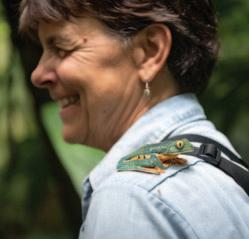
Though admittedly I was more excited about all the new species of wildflowers, I was happy to sift through the litter, trying to identify the incredibly diverse world of animals without vertebrae. Dr. Braker was the first person to show me that I could study outside. Until that class, I thought research was always conducted in cold, air-conditioned labs under microscopes. Small field classes like these are incredibly rare and yet so powerful for students. Dr. Braker’s long career facilitating these classes has inspired so many students to discover their passion for ecology and the great outdoors.
Dr. Braker encouraged me to apply for the Richter Fellowship, which sends students abroad to conduct independent research. I was chosen and elected to go to Belize, where I immersed myself in women-led grassroots conservation efforts. Working alongside kindhearted and hardworking indigenous women inspired me to apply to the Peace Corps. Again, Dr. Braker enthusiastically supported my decision, at a time when I really needed a positive force to propel me through the feelings of fear and anxiety about the two-year commitment. Without such a strong, intelligent, and encouraging female scientist in my life, I would not be the scientist I am today.
I come from a low-income family and my brave but undereducated single mother had little idea about how to navigate college and graduate school. Dr. Braker was always there if I needed ideas, direction, or inspiration to take the next step. It made all the difference in the world knowing that I had this incredibly powerful, insightful, and joyful human being in my court. I can only hope to pay Dr. Braker’s generosity and kindness forward.
Dudney is an assistant professor at UC Santa Barbara.
SPRING 2024 OCCIDENTAL MAGAZINE 19
LEFT: Professors Gretchen North, Shana Goffredi, and Beth Braker, kneeling, with their Oxy student researchers in Costa Rica in 2012.
ABOVE: Braker lends a shoulder to Cruziohyla calcarifer in 2017.
Group photo courtesy Beth Braker | Braker photo by Marc Campos

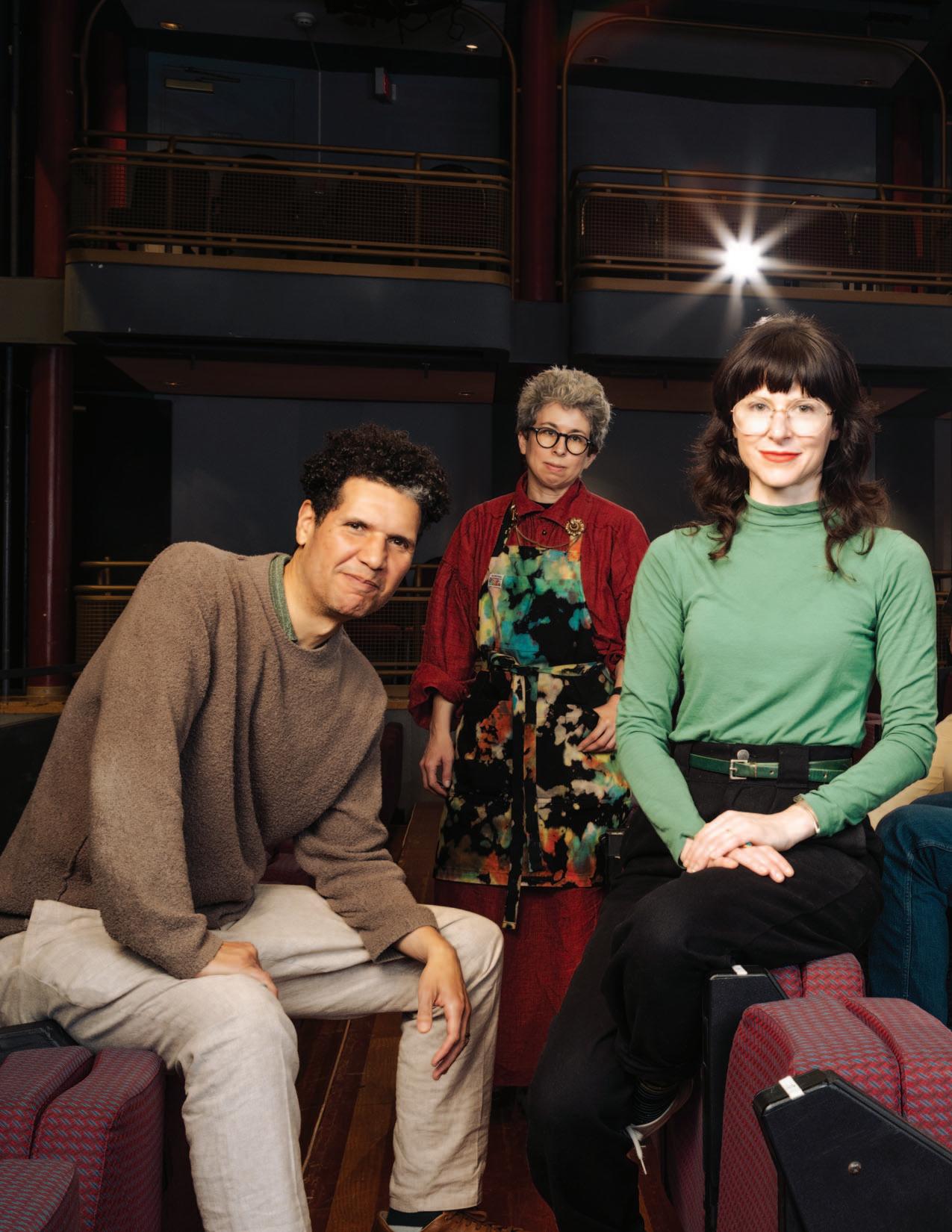
Ohmigod you guys: Elle Woods’ Delta Nu sisters perform the opening number to Legally Blonde , the musical adaptation of the 2001 novel and film and a mainstage production in Keck Theater this spring. The show was directed by Wanlass
Resetting the
Visiting Artist Dawn Monique Williams.
Will Power Assistant Professor
Aed McMillian Resident Assistant Professor
Sarah Kozinn Associate Professor Department Chair
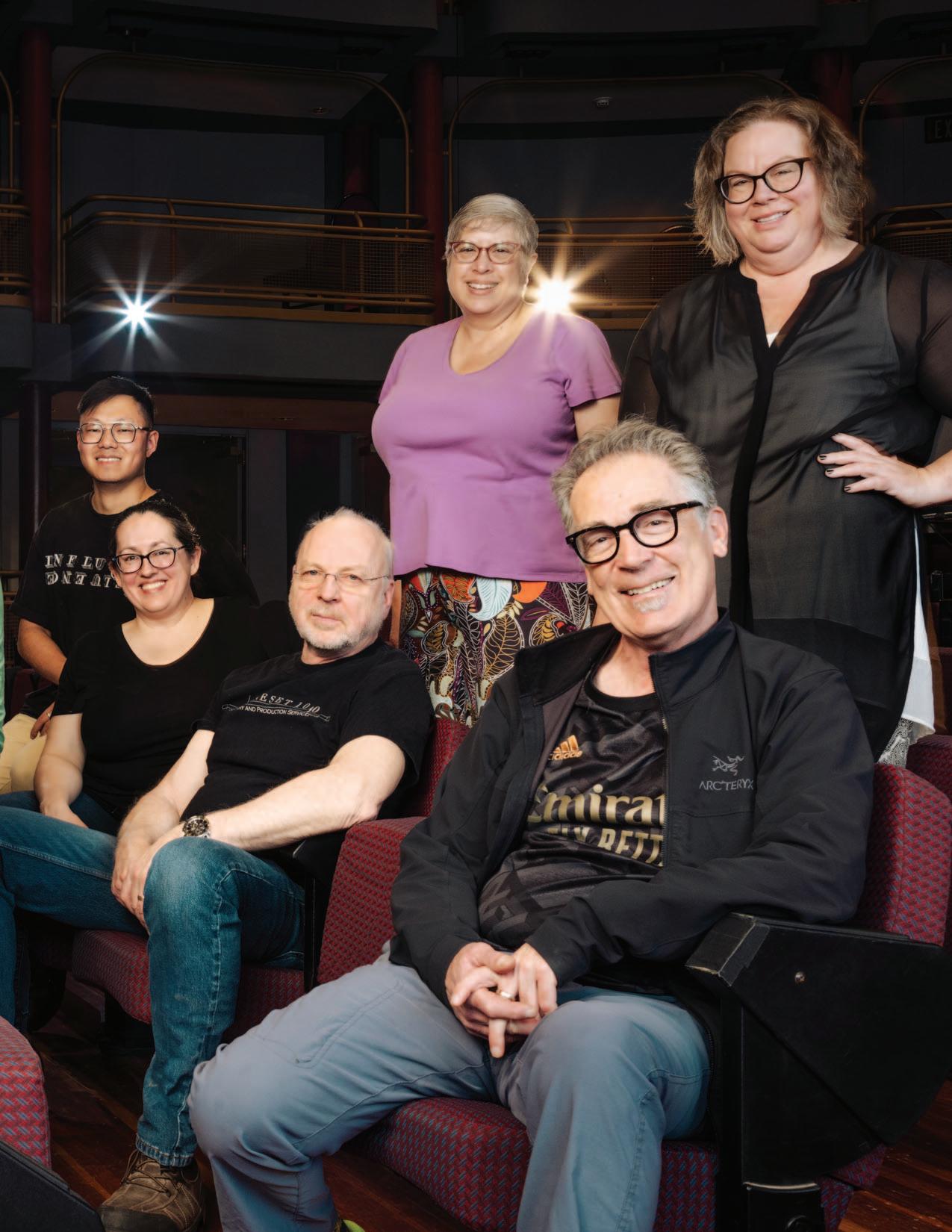
As its second century dawns, Oxy’s Theater and Performance Studies Department remixes the curriculum with a blend of theory and practice
Laural Meade ’88 Resident Professor
Beatrice Gonzales Department Coordinator
Jamie Angell Resident Professor
Aubree Day Cedillo ’95 Technical Director
Xinyuan Li Visiting Assistant Professor
Brian Fitzmorris Resident Professor
BY STEVEN VARGAS PHOTOS BY MAX S. GERBER
N THE FALL OF 1923
mere months before the birth of Omar Paxson ’48, longtime professor and patron saint of Oxy theater—Occidental established a speech education department with the hiring of Charles F. Lindsley, an actor and orator of considerable renown. (More than 110 reels and disks of his work are preserved in the College’s Special Collections and Archives.)
“Drama is the stuff of life, the very age and body of the time, the channel of ideas, the mirror of man’s struggle with himself and his environment,” Lindsley wrote in the 1928 La Encina. “Therefore, to teach an appreciation of drama as an art form, and to reveal to the playgoer something of the deep and significant values of life, is the function of dramatic study and effort.”
Lindsley remained an active presence in the department for nearly 37 years, until his death in 1960. In the century since its inception, the department has gone by a succession
of names—from Speech (1941) to Speech and Drama (1960) to Theater Arts and Rhetoric (1979) to Theater Arts (1986) to Theater and Film (1987) to simply Theater (1988).
When scholar, performer, and experimental theater creator Sarah Kozinn arrived at Occidental in 2013 as a Mellon Postdoctoral Fellow, a number of faculty stalwarts—building on the legacy of Lindsley and Paxson— were in the third act of their tenures. Alan Freeman ’66 M’67 (who taught at Oxy for 45 years) retired in 2014. John Bouchard (32 years) followed suit in 2018, and Susan Gratch (37 years) was inching toward retirement. “This department was living in a specific theatrical paradigm, which was exciting,” Kozinn says. “But I could also see potential for new directions where it could go.”
With Kozinn’s appointment as department chair in 2022 (succeeding Gratch, her Oxy mentor), the newly rechristened Theater and Performance Studies Department ushered in a new pedagogical era at Oxy that is “dilating the lens and thinking through the work of performance,” Kozinn says. But even
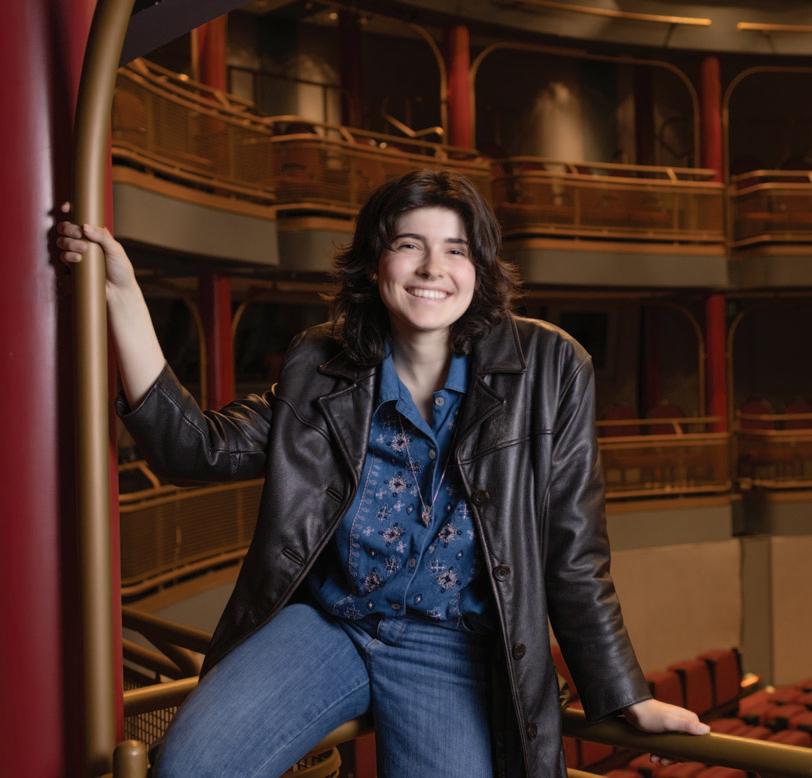
as the department leans into this new take on all things theater, its core values—performance, production, and innovation—will certainly inform its second century.
Every generation of theater faculty brings its own take on the curriculum. Kozinn comes from a performance studies program at NYU Tisch School of the Arts, “which is different from a theater department—and I think that’s why I was brought here,” she explains. “Many people tend to have a more antiquated understanding of what theater is and does, imagining it only taking place on a proscenium stage and with the primary purpose of entertaining audiences.
“If we widen the aperture to view ‘performance’ as something enacted for the purpose of being seen by others, you can then examine phenomena outside of the theater space using a performance studies lens and investigate the impact they have in and on the world. You can look at a carnival, a protest, a political rally, or look at performances of identity or culture. All of these areas come under the umbrella of performance studies.”
How does this translate into the classroom? Extended Reality, a spring semester course taught by Wanlass Visiting Artist Dawn Monique Williams, is a collaboratively built class that investigates how technology is integrated into live works. “This course is really thinking about how you integrate live and recorded performance,” Kozinn says. “During COVID, we had to contend with what it meant to do theater only in the digital space. Performing without an audience and actors in shared space, it was really a simulacrum of theater—like coffee without the caffeine.”
“Performing in drag, dance, and improv have been a pivotal part of my college experience,” says Wren Andres ’24. “All of those are types of theater.”
In many ways, the works of Assistant Professor Will Power speak to the breadth and depth of performance studies. Power, who joined the Oxy faculty in 2020, is a renowned playwright and performer whose work has been presented at Lincoln Center, the Sydney Opera House, and recently at Center Theatre Group in Los Angeles. (His next piece, Memnon—named after the biracial African king of Greek mythology who battled Achilles during the Trojan War—will run at the Getty Villa this fall.) He was named Occidental’s G. William Hume Fellow in the Performing Arts in 2009 and was a visiting professor in 2011.
Power has taught courses on the Black Arts Movement of the 1960s, rapper-songwriter Kendrick Lamar, and playwright August
22 OCCIDENTAL MAGAZINE SPRING 2024
Haowen Luo 罗浩闻 ’24 sees the opportunity to be an influence on the future of U.S.-Chinese diplomatic relations by bridging the two nations through theater.
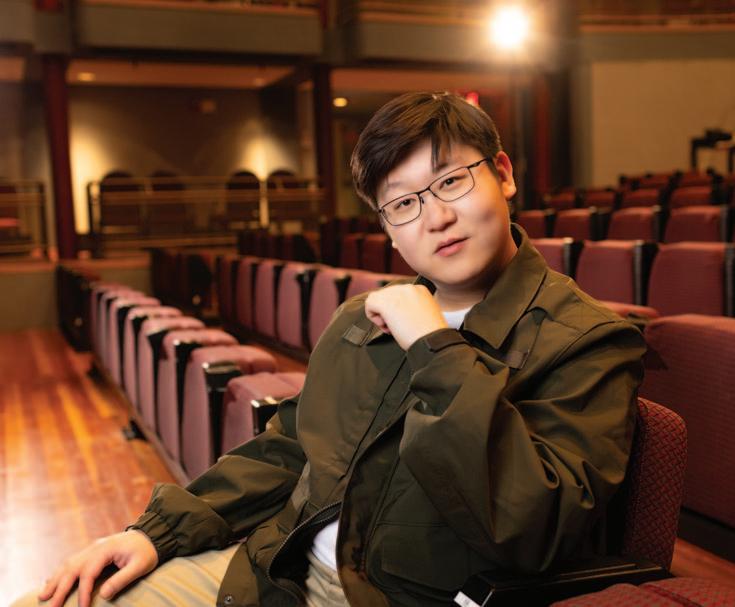
Wilson. (In February, Oxy hosted the August Wilson New Voices Competition on campus.)
A spring semester class in hip hop performance addressed questions such as: What image is the artist presenting? What are they trying to convey through their images or lyrics?
“Today in class, we’re looking at Cardi B and the complexities of what she is performing,” Power says. “She’s a political advocate. She’s also part lyricist. She’s also part stripper. What did she pull from all these things and how is she presenting it?”
Theater has a long history of being a place for ritual, accessible to all—even as the art form has grown more elite and expensive. “There’s always been a bunch of theater artists out there who manage to buck that system and do it in the street, do it on the street corner, do it in their living room,” says Resident Professor Laural Meade ’88, a playwright and performer (her current cabaret theater piece, Ms. Tucker Will See You Now, stars Meade as iconic singer Sophie Tucker) who has taught at Oxy since 1998.
“Our students have always had a scrappy, can-do way about them,” Meade adds. “That’s is what I was doing as a student many years ago, but we’re really trying to reinvest in the idea that they can make it themselves.”
Meade, who teaches playwriting, has long taken an interest in nurturing student voices through the College’s annual New Works Festival, which stages five original plays by Oxy students (and not just theater majors) each year. Meade launched the festival 26 years
ago and enlists professional performers and directors to bring students’ scripts to life.
“I’m thoroughly impressed by the rigor and invention of our students,” Meade says. “Playwriting is particularly challenging, but our students really come at it and try new things. And they’re wordsmiths.”
Wren Andres ’24, a theater and performance studies major from Glen Ellyn, Illinois, is a second-generation wordsmith. His parents are both professional writers, and his mother, Caroline (Schless) Andres ’84, was a theater major as well. A native of Highland Park, Andres spent time as a child on the Oxy campus (“I remember the pendulum”).
Encouraged by Meade to write from personal experience, Andres says, “I started writing about the relationships I have had with other trans people.” The resulting play, Emergency Contact, “a love letter to queer love and friendships,” was staged in 2023. “The New Works Festival showed me something about myself that I really didn’t know,” says Andres, who plans to pursue work in the Chicago theater community after graduation.
Many students choose a theater and performance studies major in tandem with a second academic pursuit. Haowen Luo 罗浩闻 ’24’s other major is diplomacy and world affairs, with the interest of becoming a diplomat in his native China. Over the course of his studies at Oxy, he came to recognize that a diplomat’s work can expand beyond traditional politics. He now sees theater as a form of diplomacy, especially through the cultural exchange of international productions.
Theater alumni from Oxy gathered in Keck Theater campus in February to celebrate the 20th anniversary of Lineset 10, a production service founded in 2003 by Brian Fitzmorris and Aubree Day Cedillo ’95.
BELOW: From left, Marie Scott Mawji ’01, Megan Johnson ’19, Alyssa Escalante ’10, Courtney Dusenberry ’09, Daniel Selon ’07, and Jacqueline Adorni ’11. BOTTOM: From left, Jeremy Susel ’08, Justin Kief ’05, Kari Swanson ’10, and Kirk Graves ’86.
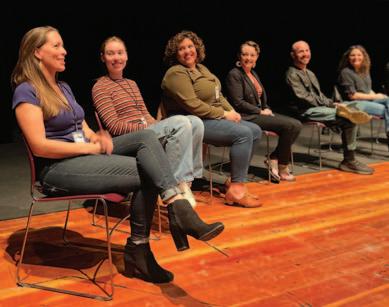
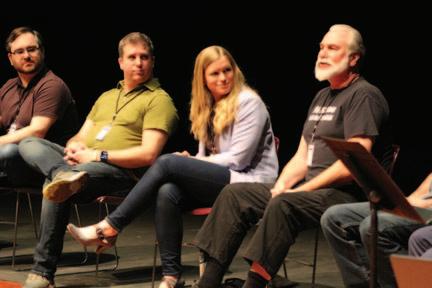
In addition to his extracurricular pursuits, Luo worked as a stage technician on campus between his sophomore and junior years and as a VIP event assistant at the Stars Asian International Film Festival in Hollywood last fall. “I have more chances to have an influence in the future working in the theater because I can still do what I want to, which is bridging the United States and China through theater,” he says.
Since 1993, Brian Fitzmorris has managed the three performance spaces on campus: Keck Theater, Thorne Hall, and Remsen Bird Hillside Theater. At the time of his hiring, the College’s Theater and Performing Arts Facilities (PAF) departments operated separately and “were at each other’s necks,” recalls Fitzmorris, who also teaches technical theater and producing as a resident professor at Occidental. “I was brought in to work with both of them and to unify them.”
All technical aspects of both Theater and Performance Studies and PAF are covered by
SPRING 2024 OCCIDENTAL MAGAZINE 23
Photos by Uma Nithipalan ’01
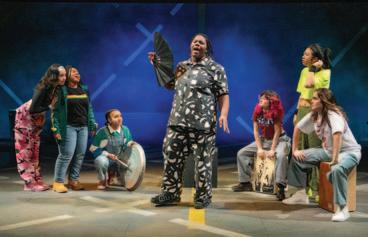


a team of four: Fitzmorris, Technical Director Aubree Day Cedillo ’95, Associate Production Manager Marie Scott Mawji ’01, and Lead Stage Technician Megan Johnson ’19.
“We work together in Keck on everything from late-night mainstage tech rehearsals to building maintenance issues to special events,” Mawji says. “While Megan and I serve as the sole on-the-ground team for all Thorne events, we also depend on Brian to manage calendars, contracts, and planning. All four of us collaborate on problem-solving or brainstorming when any issues arise.”
“I’ve watched a lot of students grow in confidence when they’re able to show what they can do in a professional environment,” says Cedillo, who has worked at Oxy since 1996. “PAF provides a really good springboard to have those credits to their name so early on in their careers.”
From plays and musicals in Keck Theater to Dance Production and Apollo Night in Thorne Hall, “It’s rewarding to know that the work I do contributes to experiences that are important and defining for a lot of students,” says Johnson. “Even being a part of the PAF student crew can be a really valued part of someone’s Oxy experience.”
Mawji was pursuing a kinesiology major at Oxy when she started working as a PAF technician. By spring semester of her senior year, she was managing the Performing Arts Facilities crew and running events in Thorne Hall. Mawji got a job offer to stay on after graduation, and she’s worked for PAF ever since. “Oxy really felt like home,” she says.
Among the many productions Mawji has worked on over the years, she singles out a few favorites: Laural Meade’s Leopold & Loeb: A Goddamn Laff Riot, from Mawji’s student
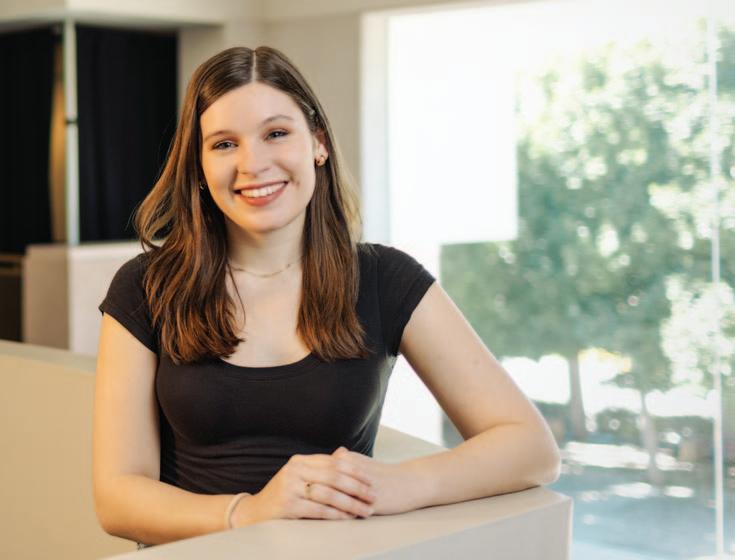
“The most rewarding and surprising education I’ve received from the department would be my technical training,” says Elinor Taylor ’24.
days in 1999; a spring 2011 staging of The Seven, a Keck mainstage production directed by visiting artist Will Power; and Carlos Santana’s supernatural performance at Convocation 2005 (“a huge production for us”).
In 2015, Mawji and her husband were married in what she calls “our beautiful third PAF space: Remsen Bird Hillside Theater. My theater family and many other wonderful colleagues from departments across campus helped make it the most unforgettable day.”
In February, scores of Oxy alumni gathered in Keck Theater to celebrate the 20th anniversary of Lineset 10, a production service founded in 2003 by Fitzmorris and Cedillo. Lineset 10 coordinates technical elements for live-event clients such as awards shows and fundraising galas in the Los Angeles area. More than 100 Oxy students have worked with Lineset 10 since its inception.
During the event, Lineset 10 alumni took to the stage to share fond memories from their time at Oxy and provide insights into their professional careers—a stellar crew that included Daniel Selon ’07, an Emmy-winning costume designer for WandaVision in 2021; Nate Genung ’07, an Imagineer at Disney Live Entertainment; Courtney Dusenberry ’09, project manager for Mattel Tradeshow Services; and nearly a dozen others, including Johnson and Mawji (who identifies as “Lineset 10 Employee No. 1”).
Mawji has helped cultivate more than 20 years worth of student crews who maintain a connection with the department, many of whom have also worked for Lineset 10. The event also underscored not only the practical skills that students develop from hands-on production but also the networking opportunities with alumni professionals.
Coming into Occidental, Elinor Taylor ’24 expected to concentrate mostly on acting,
24 OCCIDENTAL MAGAZINE SPRING 2024
LEFT: A rarely performed hip-hop gem created by the New York ensemble Universes, Slanguage was staged in Keck Theater by Will Power last November. CENTER: A young woman goes on a madcap journey to see if life is really as difficult as people make it out to be in A Dream Play, a modern adaptation of August Strindberg’s 1902 work directed by Laural Meade ’88. RIGHT: A genial workplace comedy morphs into something considerably more menacing in The Receptionist. Adam Bock’s 2007 play was directed by Jamie Angell and staged in the lobby of Keck Theater this spring.
Photos by Marc Campos (Slanguage) and Sarahi Apaez (A Dream Play, The Receptionist)

“because that has been what I’ve done since I was young,” she says. “Probably the most surprising and rewarding education I’ve received from the department would be my technical training.”
Over the last two years, Taylor has worked on the lighting for many College productions as a stage technician for PAF: “Anytime there’s a live event on campus, I’m usually behind the scenes in some capacity.”
Those two worlds came together in 2022 in the College’s production of Into the Woods (the show for which Joanna Hall Gleason ’72 won a Tony for lead actress in a musical in 1988). “I was playing Cinderella in Into the Woods while also learning how to weld the platforms that I’d be standing on,” Taylor says. “That was really exciting.”
For her senior comps, Taylor, a theater and performance studies and comparative studies in literature and culture double major from Walnut Creek, is studying Legally Blonde—the 2007 musical adapted from the 2001 novel by Amanda Brown and the subsequent film co-written by Kirsten Smith ’92—“as a period piece in the cultural ontology of the early 2000s, with a particular emphasis on its interaction with feminism and post-feminism.” Taylor’s entrée into the research was through her own work onstage as Vivienne Kensington in the College’s mainstage production of the musical this spring.
Growing up the child of parents who both worked at the local TV station, “I got a lot of free tickets to see theater, concerts, and other performances,” says Visiting Assistant Professor Xinyuan Li, a scenic and lighting designer and visual artist. “The most magical theatrical moment that always felt entrancing to me was the blackout before the show really starts. The infinite possibilities of what
you are going to see without knowing what’s behind the curtain was the trigger for me to open my mind as wild as possible from an audience perspective.”
From the other side of the curtain, he says, “I now realize how important every single choice could affect audience expectation for the given text or context.” Of the productions Li has worked on at Oxy, his favorite is A Dream Play by August Strinberg—directed by Meade and presented last November. “The show goes fully theatrical and beyond the normal-life logic,” he explains. “We created a vision that the goddess was wandering through different doors and visiting and revisiting the human world by surprise, shock, and oppression. The visual result was wonderful and all of our students were able to shine.”
Li’s Oxy colleague, Aed McMillian—a resident assistant professor since 2021 and professional costume designer, seamstress, and visual artist—likewise cites A Dream Play as their favorite production at Oxy. “I collaborated with students on some of the costume designs that appeared onstage, and that was a fun and exciting learning experience for us all. Student input enriched the creative process in unexpected ways.
“Costume construction is my most popular class, by far, and my most challenging,” McMillian adds. “Students learn various costume-making techniques, including sewing, and make pieces that appear onstage.”
Behind the curtain, Mawji says, “I’ve felt a real shift in our department goals and priorities toward choosing more diverse works, and bringing in more guest directors and artists of color, and responding to our students’ appeals to broaden our outlook.”
With the Summer Olympics returning to Los Angeles in 2028, Kozinn hopes to raise
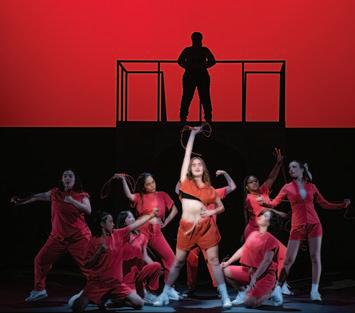
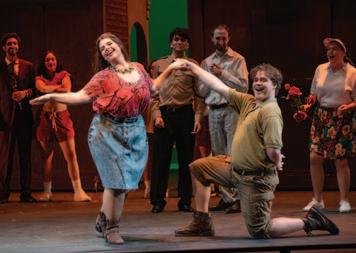
Occidental’s profile within the L.A. creative community. In 2025, the department will premiere a devised performance piece tied to the fifth anniversary of COVID-19, a project that grew out of a conversation between President Harry J. Elam, Jr., Kozinn, and Power after returning to campus following the pandemic. That conversation led to Kozinn teaching a class called Performing Disease sponsored by the Humanities for Just Communities (HJC) Mellon Grant. Working with Culture Clash co-founder Ric Salinas, the students did interviews across campus and with their families to ask about their experiences during COVID. From that workshop with Salinas, they created and performed a 45-minute devised piece for the HJC showcase last summer—which is the seed for a project that Kozinn is directing next spring.
As a student at Carnegie Mellon University in the 1980s, Fitzmorris was told that theater was dead. He’s heard the sentiment repeated many times since, yet all signs point to a healthy future for theater at Oxy. “To see new students all the time—how they evolve and what they want to learn—I think we’re going in the right direction,” he says.
Steven Vargas is a multimedia journalist, dancer, and actor based in Los Angeles.
Additional reporting by Dick Anderson.
SPRING 2024 OCCIDENTAL MAGAZINE 25
LEFT: Elle (Sabrina Sterns ’25, center) and the ensemble of Legally Blonde take the stage for the finale. TOP: Fitness mogul Brooke Taylor-Windham (Carolina Arap ’26) whips her fellow inmates into shape as the curtain rises on Act II. ABOVE: Manicurist Paulette (Theodora Aitchison ’24) finds a hand to hold onto in UPS delivery guy Kyle Hill (Theo Ellis Novotny ’26) in the crowd-pleasing musical.
Photos by Marc Campos

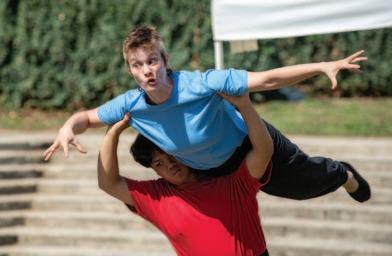
for kids 11 to 15, and a Saturday camp during the school year—an eight-week session each fall and spring for ages 6-8 and 9-12.)
of the of the
Occidental Children’s Theater has delighted audiences of all ages for 29 seasons—but what’s next after Cinderalice in Wonderland? We went to Jamie Angell for answers
BY DICK ANDERSON
OCCIDENTAL CHILDREN’S
Theater has been a staple of the Northeast L.A. community for nearly three decades now. But before it became the institution that we all know and love, there was a predecessor children’s theater company that—well, how shall we put it nicely?
“I just didn’t think it was very good or successful,” says Resident Professor Jamie Angell, an alumnus of Oxy’s Summer Theater Festival who joined the College in 1991 as an instructor in theater. “I thought, ‘I can do this better,’ because I’d had experience touring with a professional children’s theater in Thetford, Vermont. I felt I could take what we’d done there and make it even more stripped down. It was kind of hubris on my part, but it turned out fine.
“Over the years, we’ve developed a whole lot of associate programs,” he adds. “We have the Summer Institute of Fun, a four-week summer camp that caters to 6- to 8-year olds in the morning and 9- to 13-year-olds in the afternoon.” (There’s also a one-week session
To meet the demands of Children’s Theater year-round, Angell gets a course release during the academic year to manage things. But the curriculum will look slightly different next spring: Angell retired from the classroom this May. “I’ve taught here for 33 years, which seems like plenty of time,” he says. “Next year, I’ll still get my course release pay to coordinate all the yearlong stuff for Children’s Theater. In that sense, I’m not leaving.” In addition, Angell will be expanding his two-unit Children’s Theater class into a “more robust” four-unit class for the future. He’ll also continue to conceive and write the original summer production that the sixmember troupe performs, alongside three traditional folk tales from around the world, over the show’s seven-week summer run (this year’s play is titled Cinderalice in Wonderland).
“This summer will be the 29th year we’ve done Children’s Theater, so I feel like I need to get to 30,” Angell says. But will he remain with the program beyond its pearl anniversary? “I don’t know. Maybe. I couldn’t say. I didn’t think I was going to do it this long.”
Angell has been the creative spark behind Children’s Theater from the jump, working with longtime friend Nick Erickson, associate professor of movement at Louisiana State University, who with Angell ran a two-week boot camp for the ensemble each year.
With a large library of originals—from Sleeping Beauty’s Monster Truck Rally (1996) to Snow White and the 007 Dwarfs (2023)— “I want to make sure that I get these plays published so that other places can do them,” Angell says. “I’m also interested in turning the title stories into illustrated books, because I think that there’s a lot of physicality in our shows—and the images are all there. The children’s literature market is insanely competitive, but I’ll do that if I can.”
Angell also will remain busy working on projects for his Lincoln High School buddy
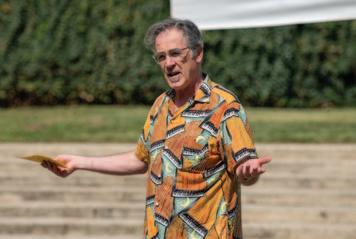
and Komix Appreciation Klub co-founder, Matt Groening. In addition to serving as story editor on the five-part Netflix series Disenchantment, Angell interviewed the animators behind Futurama for a new book titled (appropriately enough) The Art of Futurama, to be published by Abrams in October.
But his heart is clearly with Occidental Children’s Theater, which has remained selfsustaining all these years without any direct funding from the College. “It probably took us six years before we really figured things out, but we’ve been solidly in the black ever since,” Angell says. “We’re supported by box office revenue, grants, and donations. And our summer camp tuition allows us to pay the actors more, while generating enough additional revenue so we can offer camp scholarships to kids who need them.”
Given all that, he admits, “I’m loath to go away, because I’m that little gluey part that holds things together. So much of what we do is in my head—and maybe that’s on me—but when is there time to write things down? You can’t just follow a set of rules; the experience is in your lived understanding of how to deal with whatever circumstances arise.”
While Children’s Theater draws somewhere close to 2,000 patrons to see the show at Remsen Bird Hillside Theater each summer, the numbers run much higher when you add in the touring shows. “We’ll visit a rec center and there’ll be 60 to 80 kids there, so that’s another 400 or 500 for the six shows we do. And then we do three shows at Eagle Rock Elementary in the fall because that’s where my son was going when I started the program, and that’s another 600 students.
“He’s 31 now—that’s really old,” Angell adds with a chuckle. But if he’s anything like his dad, there’s still a child inside.
26 OCCIDENTAL MAGAZINE SPRING 2024
FAR LEFT: Performers from the 2023 Occidental Children’s Theater production of Snow White and the 007 Dwarfs in Remsen Bird Hillside Theater. LEFT: Amanda Wagner ’16 goes airborne in the 2021 revival of The Boy Who Cried Wolfman. BELOW: Children’s Theater auteur Jamie Angell.
Photos by Marc Campos

Neighborhood Watch
EAGLE ROCK AND HIGHLAND PARK HAVE BECOME MAGNETS FOR NEW BUSINESSES, INCLUDING THE RESURRECTED EAGLE THEATRE (NOW HOME TO VIDIOTS). WHAT’S CHANGED—AND WHAT’S STILL IN FASHION?
By DICK ANDERSON
with JASMINE TERAN | Photos by MARC CAMPOS
alk to any Oxy alumni long enough about their fondest college memories, and inevitably the conversation will turn to their favorite destinations close to campus. Eateries rank high on any list, and many longstanding favorites remain in business today—Casa Bianca (founded in 1955), Pat & Lorraine’s (1977), and Señor Fish (1995) among them. With a constant influx of new businesses, it was hard to limit this list to 10 notable neighbors new and old, but we tried. (Share your favorites with us.)
If streaming movies is not your scene:
Vidiots
4884 Eagle Rock Blvd.
Maggie Mackay traces her love of film to Rare Bird Video—the neighborhood video rental store that she grew up with in New York City in the 1980s. Through her work as senior programmer of the Los Angeles Film Festival, director of nominations for the Film Independent Spirit Awards, and myriad other roles over the last 25 years, “I’ve always been very devoted to connecting audiences with film and connecting artists to audiences,” she says.
As streaming grew in popularity—embodied by Netflix’s shift away from its bedrock mail-order video rental service—Mackay grew increasingly vocal about her concerns with a streaming-only world. “I was largely dismissed by most of my colleagues—and many of my friends—as a bit paranoid,” she recalls.
But because she was vocal enough about it, several friends and colleagues in the film industry quietly started reaching out to her amid rumors that Vidiots—the iconic Santa Monica video store turned nonprofit foundation dedicated to preserving and sharing physical media—was struggling to survive. “I think of Vidiots as a cornerstone of culture in Los Angeles,” Mackay says. But even with a philanthropic lifeline from two major donors in 2015, the organization needed an executive director with the vision to keep Vidiots alive.
“I had never raised any money before— I really was squarely in the curatorial space— but my passion definitely came into play.” Mackay says. The first time she met Vidiots co-founders Patty Polinger and Cathy Tauber, “I just knew there was no way I was gonna be able to walk away from it,” she says—and
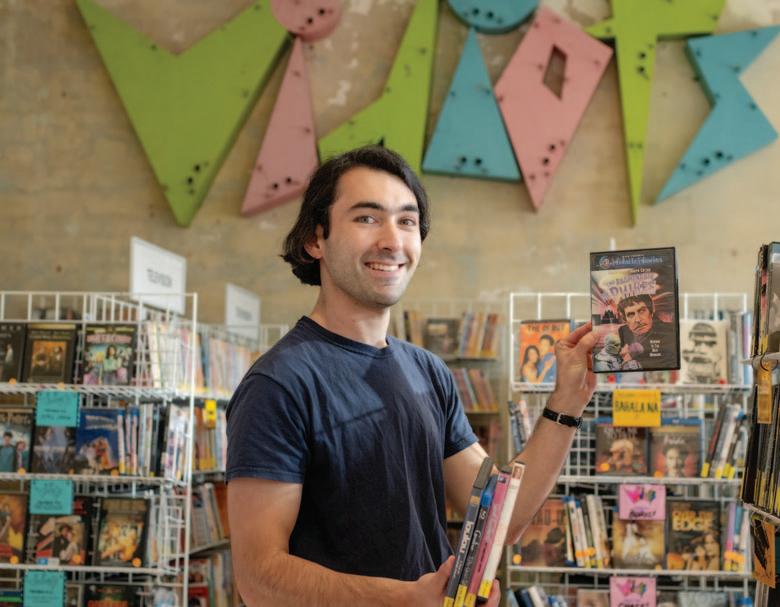
in 2016, she joined Vidiots as its first executive director, a position she retains today.
“They took a huge risk on me—I didn’t have any experience raising money or leading an organization in that way,” Mackay admits. Nevertheless, she has been instrumental in raising more than $2.4 million to relaunch Vidiots and rehabilitate the Eagle Theatre— an improbable outcome for a venue that had not screened a movie since 2000. How did that come to pass?
“Having lived on the Eastside of Los Angeles for almost 20 years, I knew that what we were really missing over here, especially Northeast L.A., was a gathering space for film lovers and a real independent movie theater.” From gas stations to warehouses, “I was looking for anything big enough to house the collection so that we wouldn’t sacrifice the video store to open a theater. The heart and soul of our project is the video store.”
What she did not expect to find was a historic movie theater—much less one, like the Eagle, whose landlords had been former customers of Vidiots going back to the 1980s. “They very much wanted the theater to stay an art space, and they liked the idea of the space being run by women,” Mackay says.
“Patty and Cathy were really ahead of their time when it came to supporting independent artists and to connecting their work to audiences,” she adds. “And they were also ahead of their time when it came to understanding what a community space for everybody would look like. Sometimes I think that the success of the movie theater has been so
Vidiots’ collection of more than 50,000 DVDs, Blu-rays, and VHS tapes makes it a destination for any film enthusiast. “To paraphrase a line from The Player: ‘Physical media, now more than ever!’ ” says volunteer Pablo Nukaya-Petralia ’20.
immediate and impactful that Vidiots’ legacy as an L.A. entity gets a little bit clouded.”
Vidiots already enjoys “a lovely community collaboration” with Oxy, Mackay says, “and we’re committed to further deepening our relationship.” In March, the Media Arts and Culture Department presented a Vidiots screening of writer-director Charles Burnett’s To Sleep With Anger (1990), including a Q&A with Burnett and composer Stephen James Taylor. “We had an incredible group of students there with [Visiting Assistant Professor] John Trafton’s class,” Mackay says. “We’re looking forward to welcoming more students both for events but also an internship program, which we hope to launch soon.”
An art and art history alumnus of Oxy, Pablo Nukaya-Petralia ’20 started volunteering at Vidiots in May 2023, just before its official opening that June. “I began literally my first day back in L.A. after grad school,” he says. “I split my time between the video store and the theater, so on any given day I might be renting out to customers, organizing the store, scanning tickets, or chatting with visitors.”
He enjoys the organic discovery that comes from being in the store, “where I can very easily follow my own personal interests without being impeded by a streaming platform not owning the rights to a certain title.
28 OCCIDENTAL MAGAZINE SPRING 2024



May 10, 1929: The Yosemite Theater opens at the corner of Yosemite Drive and Eagle Rock Boulevard with a vaudeville revue and the pledge of “clean, wholesome, up-to-theminute entertainment.” On May 12, the Yosemite screens its premiere feature, The Younger Generation, starring Jean Hersholt and directed by Frank Capra.
June 1937: Following a remodeling, the venue reopens as the New Eagle Theatre (shortened to the Eagle Theatre in 1939).
Fall 1974: Walnut Properties President Vincent Miranda— operator of the Pussycat adult movie theater chain—
It’s nice to have a place that lets me indulge in exactly what I want, like watching the complete works of Parker Posey or Grateful Dead concert films.”
Nukaya-Petralia completed his master’s in art history from the School of the Art Institute of Chicago, where he wrote his thesis on the collages of artist and author Eve Babitz. In addition to volunteering at Vidiots, he is working as a studio assistant for a composer and aiding with music for a “very exciting documentary” that should be coming out this fall, as well as writing his own music (he keeps his personal copy of Todd Haynes’ 1995 film Safe on his desk for inspiration).
“Organizations like Vidiots do the important work of maintaining access to new and old works that had a limited release, were pulled from a streaming service, or are simply hard to find,” Nukaya-Petralia says. He implores readers to support small businesses and nonprofits that champion physical media.
“It’s not easy running a movie theater,” Mackay adds. “Every day it’s like whack-amole, with a new problem to solve. But when we get positive feedback from the community, it really puts gas in the tank.
“Last night, we had over 100 people for Goodbye, Dragon Inn (2003), which is a Tsai Ming-liang movie nearly without dialogue. And people stood outside talking about it for an hour after the movie ended. There aren’t too many places where you’d see that kind of response. So, it’s a joy to show movies here. It makes all of the complexity and difficulty worth it 100 times over.”
buys the Eagle, prompting fears of bringing X-rated films to the neighborhood. (On Figueroa Street, the Highland Theater screens Deep Throat and other adult fare until protests from a group called Stamp Out Pornography, aka STOP, shuts it down in December 1974.) Contrary to legend, the Eagle never shows pornos: After Walnut spends $50,000 to refurbish the theater, Steven Lane’s Great Western Theaters chain leases the Eagle, losing more than $15,000 in seven months of operation.
October 1975: Emilio Lujan subleases the Eagle from Great Western, screening mainstream fare (including
monthly screenings of family films sponsored by local law enforcement). After Lujan closes the Eagle in December 1976, the theater remains shuttered for 21 months as Walnut seeks a new tenant —or a new owner.

August 1978: The Eagle reopens under new management, mixing second-run fare with celluloid classics. Ads in the Occidental newspaper tout $1 tickets for students on Wednesday nights.
If you’re looking for cold comfort:
Foster’s Freeze
4967 Eagle Rock Blvd.
Nearly 16 years after entrepreneur George Foster opened his first Foster’s Freeze in Inglewood—bringing soft-serve ice cream to the Southern California masses—the franchise came to Eagle Rock in January 1962. Countless cones, dishes, sundaes, and shakes have been consumed ever since. Fast-food neighbors may come and go— KFC gave way to Del Taco in 2016, and the Burger King next door was recently razed, to be replaced by another Starbucks—but Foster’s Freeze is thriving. In an Instagram poll last fall, Oxy students were asked, “What classic spot is still a student fave?” Foster’s Freeze (39%) iced the competition, outpolling Colorado Boulevard mainstays Cindy’s (34%) and Casa Bianca (26%).
In a decidedly unscientific survey on Facebook, ’80s-era Oxy alumni shared their own Foster’s faves. “The Peanut Butter Milkshake was a large contributor to my ‘freshman 20’—made worse when we actually bought a blender and made our own in the dorm,” Jill (Johnson) Gold ’83 recalls. “For me, it was a Peanut Butter Chocolate Shake,” adds Bill Cochran ’88. “The Root Beer Freeze was excellent,” raves Breck Tostevin ’83. Whether it’s because of the restaurant’s royal-blue exterior or its authentically throwback vibe, Foster’s Freeze occasionally slips into the culture as well. The Atwater Village location pops up in Quentin Tarantino’s Pulp Fiction (1994), and last year, eagle-eyed New York Times readers may have clocked a glimpse of the Eagle Rock eatery accompanying a profile of actress Sasha Calle, who
2000: After decades of fits and starts, the Eagle closes as a theater for the last time. In the early 2000s, the building gets a new tenant: the Brazilian-based Universal Church of the Kingdom of God, which operates there until April 2019.
June 2023: Nearly 3½ years after signing a lease with the owners of the Eagle, Vidiots opens for business.

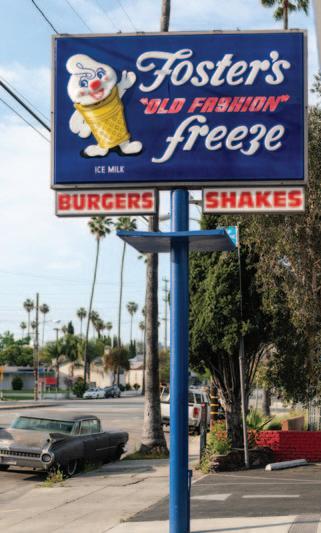
appeared as Supergirl in 2023’s The Flash). George Foster sold his interest in the company in 1951, and Foster’s Freeze has changed corporate ownership multiple times. While the number of locations is down considerably from its peak, new Fosters franchises are springing up in California. Fosters dropped the apostrophe years ago, but the punctuation mark remains a fixture on the signage at older locales such as Eagle Rock.
“Little Foster,” its smiling soft-serve mascot, greets patrons of all ages—and with temperatures rising, the prospect of a chocolatedipped cone sounds too good to pass up.
SPRING 2024 OCCIDENTAL MAGAZINE 29
If you need a cup of coffee:
Café de Leche
5000 York Blvd.
Anya Schodorf’s mother, Rosa, was visiting from her native Nicaragua while Anya and her husband, Matthew, were in the planning stages of opening a cafe in Highland Park. As Anya tells the story, “We were having breakfast and there it was—my mother calling out to my husband, ‘Mateo, pasame mi café de leche.’” Matthew turned to Anya and declared, “That is it. That will be the name of our cafe.”
The Schodorfs launched Café de Leche in 2008, and its small-batch, hand-crafted coffee quickly gained a following in the Oxy community. The following year, then-President Jonathan Veitch arrived on campus, and he fast became a superfan. “I used to go there every day before work and order a large iced latte,” he says. “My
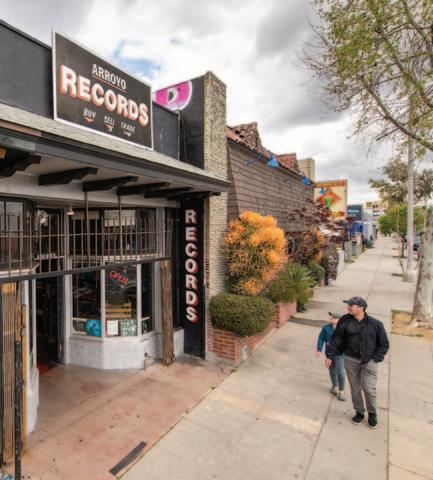


wife, Sarah, and I became very good friends with the owners. Since then, Café de Leche has moved out to Altadena [opening a second location in 2015]—and so have we!”
In an Oxy Instagram survey last fall, Café de Leche brewed up a win in the uber-competitive coffee category, with 39% of the vote, edging out nearby Kumquat Coffee Co. (31%), and Muddy Paw (30%) on Eagle Rock Boulevard. Its comfortable couches—as well as a tasty selection of
If spinning vinyl is your thing:
Arroyo Records
5123½ York Blvd.
Growing up in Chino Hills, Daniel Clodfelter got turned on to vinyl records while exploring his dad’s record collection—from Buffalo Springfield to the Repo Man soundtrack (1984), with songs by Black Flag, Suicidal Tendencies, Iggy Pop, and other hardcore punk icons. “That album really got me into ’80s punk,” says Clodfelter. He soon started collecting vinyl himself, buying his first turntable at age 18 and parsing through countless record store bins around the country over many years as a touring musician.
At the beginning of COVID, Clodfelter was working at a health food store in San Dimas—his day job for 17 years—and a new dad. “When everything was shutting down, I took a tiny break—my son was 6 months old,” he recalls. Turning to other means to make money, he started selling large chunks of his record collection online, “and it just snowballed from that.”
Today, Arroyo Records occupies a York Boulevard space that has been a destination for vinyl enthusiasts for the last decade. It previously housed Permanent Records, whose owner, Lance Barresi, reached out to Clodfelter when he was looking to relocate. By then, Clodfelter had started selling his friends’ collections as well, “and I started to think about storefronts when this opportunity came
pastries, bagels, and tamales—make it ideal for a study break or catching up with friends.
“Sometimes when I take my first sip of café de leche in the morning, as if by magic, my soul is transported back home,” writes Anya, who grew up in San José, Costa Rica, and Glendale. “The aroma of the coffee in the house flirts with my senses and creates a feeling of comfort, a feeling of home, a sense of family.” For the Schodorfs’ Oxy family, Café de Leche feels like home.
along,” he says. In September 2020, he quit his other job to devote himself to running Arroyo Records full-time. “I just ran with it and it’s been great.”
Clodfelter keeps his inventory fresh by constantly replenishing the store’s offerings with vinyl gems from newly acquired collections. (The “coolest thing” he’s ever found? A 1967 promo copy of The Velvet Underground & Nico among a stack of dollar-binquality classical LPs.) “It’s really fun seeing people’s collections and hearing their connection with the records and meeting people whose tastes are similar to mine.”
Arroyo Records’ inventory is about onethird new records, with the rest being mostly used vinyl. (There’s a tiny space dedicated to cassette tapes, and Clodfelter is “trying to figure out how to fit CDs in here, too.”)
The demographic for the store is “all over the place,” he says. “There are high school kids, college students [including Oxy], and people who’ve been buying records since the 1960s.” And, of course, there are Swifties: For Record Store Day in May, Clodfelter got an allotment of 20 copies of The Tortured Poets Department, with an exclusive postcard from Taylor. Those LPs sold out quickly.
On the home front, Clodfelter is raising a next-generation music fan: his 4-year-old son. “He has a few favorite records. He likes Lana [Del Rey] and old doo wop and ’50s rock ’n’ roll like the Trashmen. He likes the Charlie Brown cartoons so he likes ‘Charlie Brown,’ by the Coasters. He’s a cool little dude.”
30 OCCIDENTAL MAGAZINE SPRING 2024
Arroyo Records recently made the Los Angeles Times’ list of the 40 best record stores in and around the city. In addition to regularly acquiring new collections of old vinyl, “I buy from eight to 10 distributors to keep the selection wide-ranging and to get the best deals,” says owner Daniel Clodfelter.
Café de Leche’s flagship location opened in 2008.
If you’re visiting Oxy Arts:
Bagel+Slice
Skaf’s on York
In 2015, Occidental College purchased a 5,400-square-foot commercial building on the northeast corner of York Boulevard and Armadale Avenue—just a block south of campus. In addition to luring the emerging York retail scene closer to the College, plans were to renovate the building “to make it more obvious that Oxy is nearby,” thenDirector of Communications Jim Tranquada noted. (The prior tenant was the Ocxy Store, a purveyor of liquor and convenience goods.)
Plans came together to restore the 1920s structure into three distinct spaces—and in May 2019, Oxy Arts, the College’s community-based arts hub, opened its doors at 4757 York Boulevard. But it would be three more years before the first of two new restaurants would open in the adjacent spaces.
First up was Bagel+Slice, Blaze Pizza cofounder Brad Kent’s latest contribution to the culinary landscape and his initial foray into bagels after years of tinkering with his recipe. Months later, Kent approached longtime associate Michael Robles—manager of his Olio Wood Fired Pizzeria in Grand Central Market—with an offer he could not refuse: the chance to buy not only Olio’s Market location but Bagel+Slice as well.
“Brad has a good heart—that’s a big opportunity that he gave to me,” Robles says sitting outside Bagel+Slice one afternoon in mid-April. “I’m going to continue his legacy and do everything good, but I think it’s going to be even better.”
Robles has already brought a bit of Mexican flair to the menu, serving up a Oaxacan mole pizza with ingredients straight from Mexico. From pizza to bagels, “I make everything right here—the dough, the sausage, the onion sauce, everything is in-house,” he says. “The neighborhood is really nice and more people are coming here all the time.”
One door down, brothers Daniel and Chris Skaf opened Skaf’s on York in March 2023—the latest iteration of a family-centric franchise that dates back to 1999. That’s when their dad, Salim, opened Skaf’s Grill in





Bagel+Slice’s offerings include an everything bagel with lox, cream cheese, capers, and dill, and a Margherita pizza. ABOVE: Shish kebab and shish tawook from Skaf’s on York, with an exclusive vegan pom-berry sorbet from Moo Moo Mia.
North Hollywood in 1999. “My aunt had always been the chef in the family, and a lot of recipes are hers,” Chris explains. A quartercentury ago, “The restaurant industry was so different,” he adds: “There was no social media, everything cost much less, and you could take your time to develop a client base.”
As the brothers got older, they started helping out more with the family business— both at their dad’s original location as well as their mother’s offshoot, Skaf’s Lebanese Cuisine in Glendale, which opened in 2007. “My brother and I always wanted to do our own thing,” Chris says—and in 2012, he and Daniel stumbled upon a space on Brand Boulevard in Glendale. Subsequently, they
opened the third Skaf’s location that July. But over Memorial Day Weekend 2013, an early-morning fire broke out in the building when an appliance short-circuited in the apartment above the restaurant—and the entire structure was demolished in 2014.
After opening a side project in Glendale, selling Cornish hens and chicken sandwiches, the brothers signed a lease with Oxy in 2019 to bring Skaf’s to York Boulevard. “I’ve always wanted to be in Northeast L.A.,” Chris says. Six months later, the pandemic hit.
“I didn’t expect Oxy to help out,” he continues, “but the College told us, ‘Take your time. Once things get back to normal somehow, we’ll restart everything.’ And that gave us the breathing room to wait it out and then start construction,” he adds. “We’re forever grateful for how Oxy treated us then and how they continue to treat us.”
Each Skaf’s location has a slightly different vibe. “My dad’s is a typical hole-in-thewall—you come for the food, you come for the environment. Glendale is a little bit bigger in terms of the dining room, but that place is strictly about the food. For this one, we didn’t want to make it too nice where people can’t come here for casual dinner. This feels nice and approachable.”
After about six months of takeout only, Skaf’s on York expanded to full service last September. From shawarma to kebabs, “This food tastes even better when you can enjoy it on-site,” Chris says. “It’s so great to eat here and share with other people.”
SPRING 2024 OCCIDENTAL MAGAZINE 31
4751 York Blvd.
4753 York Blvd.
TOP:
Next-door neighbors: Michael Robles of Bagel+Slice, left, and Chris Skaf of Skaf’s on York.

If you’re a kid at heart:
Bob Baker Marionette Theater
4949
Bob Baker’s career as an animator and puppeteer began after World War II, and in the decades to follow he would work in film (G.I. Blues, Bedknobs and Broomsticks, Close Encounters of the Third Kind), TV (Bewitched, Star Trek, NCIS), and theme parks (lending his design skills to Disneyland’s Main Street). But his biggest contribution to the entertainment landscape came in 1963, when he and partner Alton Wood turned a dilapidated special effects workshop near downtown Los Angeles into a live puppet



theater and family entertainment institution: the Bob Baker Marionette Theater.
In addition to entertaining generations of L.A.-area schoolchildren, the theater was home to Baker’s collection of more than 4,000 handcrafted marionettes and was designated a Los Angeles Historic-Cultural Monument in 2009. It remained open until 2018, when it lost its lease four years after Baker’s death. Westlake’s loss is Highland Park’s gain: In 2019, the theater signed a 10-year lease to relocate to a 10,000-square-foot space at the corner of York Boulevard and North Avenue 50, which was built as a vaudeville theater in 1923. Over the last five years, “We have expanded a little bit each year in terms of using the space,” says Mary Thompson, BBMT’s director of communications. “We have a storefront now; we have people working on fabric restoration and fabrication; and we have the main theater. It’s a great home for us.”
Inside the crimson-red theater, puppeteers perform in the round, “and they use all of the space,” Thompson says. “Kids especially like to sit on these floor cushions, so the puppets will come up and actually interact with them—maybe sit on their lap, pat them on the back, that kind of thing.” There are theater seats along the perimeter as well. as recently completed puppet parlors overlooking the stage with additional seating.
Despite a seating capacity of around 100 people per show, BBMT’s theater space hosts around 20,000 visitors per year. Seasonal shows such as the Halloween Spooktacular and Holiday on Strings are among the most popular offerings, and the Nutcracker show “is an annual tradition for a lot of folks,” says Thompson, who saw the show growing up.
On April 13, Hooray LA!—created in 1981 for the L.A. bicentennial and regarded as Baker’s masterpiece—returned with two new puppets (a bear and a rainbow trout) for its latest iteration, having added a mountain lion last year. Hooray LA! runs through June 16.
Its summer show, Enchanted Toy Shop, will include three new numbers that are slated for next year’s Choo Choo Revue, BBMT’s first fully original production in 40 years. “It’s a big undertaking, but it’s something we’ve wanted to do for a while,” Thompson says.
“We always say our shows are from ages 2 to toothless,” she adds, “but we have Friday night shows that attract a younger adult audience with special extras, like food pop-ups and vendors. And we do see Occidental students coming to those.”
Prior to opening to the public at its new home, the theater staged a kids’ workshop at the neighboring Oxy Arts building in 2019. BBMT has had Oxy Arts interns over the last couple of years—most recently Jonah de Forest ’24 and Willa Caspole ’24, both theater and performance studies majors—who largely helped in organizing their archives.
On April 21, an estimated 25,000 people turned out for the 10th annual Bob Baker Day at L.A. State Historical Park. “Each year we have special guests, variety acts, music, mimes, and clowns, as well as a marketplace with artisans, vendors, food trucks, and a ton of free activities,” Thompson says. “At its heart, it’s a celebration of Bob and his legacy.”
But if you want the full Bob Baker experience, the theater is the way to go—and at the end of every show, everyone gets ice cream. (That’s supposed to be a surprise, so let’s just keep that between us.)
32 OCCIDENTAL MAGAZINE SPRING 2024
York Blvd.
TOP: Inside the renovated York Theater space before and during a show. CENTER: Something to Crow About is a classic springtime show about a musical day on the farm—with marionettes, of course. ABOVE: House organist Edward Torres.
Photos by Chloe Rice/courtesy Bob Baker Marionette Theater
If you’re hungry for a breakfast burrito:
Delia’s
4501 York Blvd.
When Delia’s restaurant opened for business in 2002, neighbors warned owners Delia and Adolfo Flores that every prior restaurant in the space had closed shop within a year. The couple was unfazed. “If your food is good, you have business wherever you go,” Delia told The Occidental newspaper in 2016.
Delia’s offers one of the best deals in town for current students: a discounted $6 breakfast burrito that is no-frills, beyond filling, and delicious any time of day. Make yourselves at home at this Oxy institution (just don’t forget to bring cash; credit cards are not accepted).

If you need a casual neighborhood nosh:
5100 York Blvd.
A casual neighborhood eatery in Highland Park, Joy serves up regional Taiwanese cooking inspired by Taiwan’s street food culture, such as minced pork on rice and thousandlayer pancake. Similar to Joy’s sister restaurant, Pine & Crane in Silver Lake, some of its dishes can be traced to the northern-style Chinese dishes chef Vivian Ku’s maternal grandparents grew up with before moving to Taiwan in 1949. Joy’s scallion sesame bread is baked in-house daily and sold by the loaf.
Joy opened its doors in 2018 in the longtime home of Elsa’s Bakery, a neighborhood fixture from 1976 until its closing in 2016. As an homage to Elsa’s founders Manuel and Elsy Vargas, Joy bakes Mexican wedding cookies daily and donates all the proceeds of cookie sales to a nonprofit partner in the area each month, “as we believe in contributing to the community we call home,” Ku says.
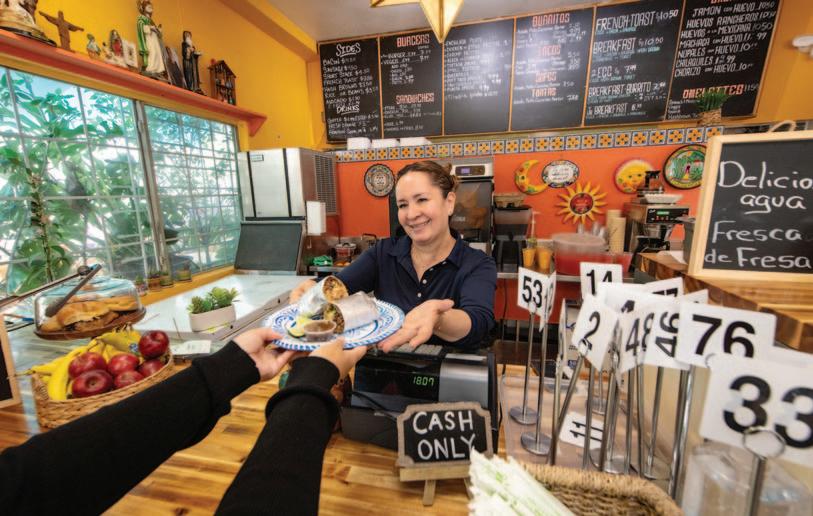
If you’re craving something sweet:
Berry Bowl
5056 York Blvd.
“Ten years ago, I came to Highland Park for a weekend of fun,” Meirav Leibovici recalls. “I have always been pretty health-conscious, and when I spent the day here, I realized there were no health food stores. It was mostly pizza and tacos.” With more young families moving east, Highland Park was poised to become “the new, artistic, familyoriented community,” she adds. “I wanted to do something with food and beverage that would enrich the lives of the people here.”
In researching the marketplace, Leibovici found that frozen yogurt was on the decline in addition to being “chemical, synthetic, sugar-added.” By comparison, acai—a superfood—was fruit-based, gluten-free, and dairy-free, with “tons of antioxidants,” she says. “And you could turn that into a healthy option and actually have fun with it because you could layer it with granola and fruits and seeds.”
Thus, Berry Bowl was born.


In an Instagram survey, we asked Oxy students: “Where to walk to for something sweet?” It was a berry competitive category, but Berry Bowl came out on top, with 38% of the vote—sweet victory for Leibovici. “Berry Bowl is literally my baby because I created it from nothing,” she says. “When I walked into this space, it was a storage unit. There was a single, flickering lightbulb dangling from the ceiling.”
In addition to building a business from the ground up, Leibovici hired a vegan chef to help her create the recipes. “We worked on it for over a year to perfect everything,” she says. “Berry Bowl offers a little bit of
everything for everybody. If someone has a nut allergy, we have other options. We don’t do anything with dairy, and we have a lot of sugar-free options if someone’s diabetic.”
Earlier this year, for a volunteer cleanup of Highland Park, Leibovici prepared 20 juices and smoothies to give to participants “so they could have something nice to drink,” she says. “Highland Park is great, and everybody should help each other.”
Berry Bowl turns 10 in November, and Leibovici couldn’t be happier. “The feedback from my customers is very gratifying. I love my staff and the energy in the store is always positive. It’s fun to come up with new recipes. I love it all.”
SPRING 2024 OCCIDENTAL MAGAZINE 33
Students in Assistant Professor Aleem Hossain’s 360 video class gather footage using 360-degree video cameras at the solar ar
ABOVE: In addition to its flagship Highland Park location, shown here, Berry Bowl opened a second store in Manhattan Beach in April. INSET: Great bowls of acai!
Joy
Delia Flores serves up a burrito in her namesake restaurant.
Photos courtesy Berry Bowl

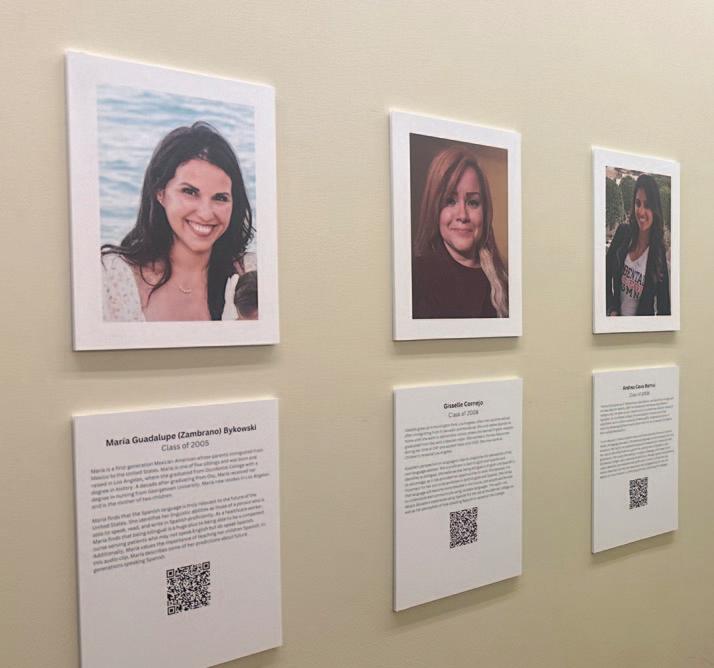
Voices of OCLAA
Realizing a long-standing goal of Occidental’s Latino Alumni Association, two dozen alumni share their stories with students for an oral history project
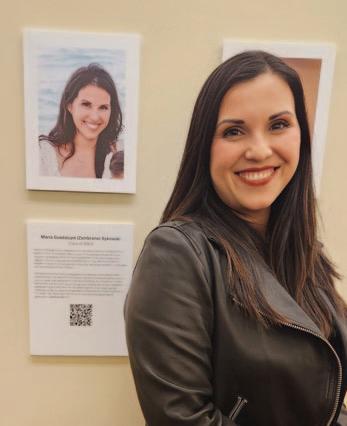

As a college access counselor and podcaster (The College Match Podcast and Inspired Conversations With Changemakers in Higher Education), “Storytelling truly is in my blood,” says Andrea Cova-Bernal ’08, who recently completed a term as president of the Occidental College Latino Alumni Association (OCLAA). “I love sharing powerful stories, and to do it in collaboration with one of my favorite Oxy professors was truly an honor.”
Cova-Bernal is talking about Associate Professor of History Alexandra Puerto, with whom she served on a community-wide diversity committee organized by David Carreon Bradley, Oxy’s then-vice president for equity and justice. “The topic of storytelling came up,” Puerto recalls, “and Andrea said that she was really interested in working on storytelling projects in association with OCLAA. So I chimed in and said, ‘If you ever want to discuss this further, let’s meet.’ ”
At a faculty retreat in May 2023 attended by instructors to discuss the fall semester of offerings in the Humanities for Just Communities (HJC) program for first-years, “We started planting the seeds for the kinds of social justice projects that our courses would have,” Puerto continues. “When I was mulling over possibilities for my course (Eating Culture: Food, Race, and Migration), I had two in mind—one of them being an oral history project with OCLAA.” During a roundtable discussion, Mariška Bolyanatz Brown, assistant professor of Spanish and linguistics, expressed an interest in participating through her class (Linguistic Resilience in Los Angeles) as well. “Mariška is a pro with interviews—it’s so much a part of her research and teaching,” Puerto says. “So we decided then and there that we were going to start this project.”
With an enrollment of 12 students in each class, there were 24 oral histories to co-
34 OCCIDENTAL MAGAZINE SPRING 2024
OXYTALK
above: Lupe Zambrano Bykowski ’05 finds that being bilingual is a huge plus as a healthcare worker. In the audio excerpt at left, she shares her predictions about future generations speaking Spanish.
Photos courtesy Andrea Cova-Bernal ’08 and Mariška Bolyanatz Brown
Student interviewers displayed and discussed their work on the OCLAA oral history project in the Academic Commons February 9. Left page: From left, Alexandra Puerto, associate professor of history; OCLAA president Andrea Cova-Bernal ’08, and Mariška Bolyanatz Brown, assistant professor of Spanish and linguistics.
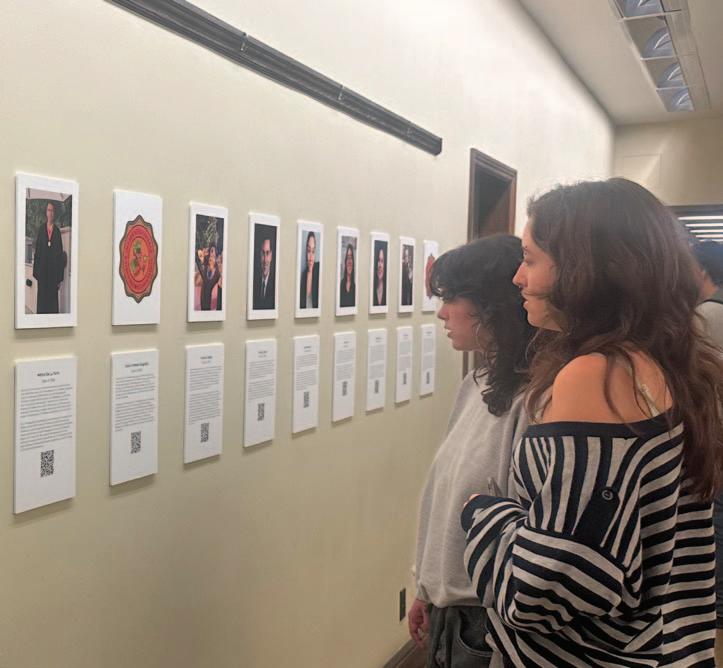
ordinate. With Cova-Bernal as lead liaison, she and the rest of the OCLAA board put out multiple calls for alumni participants. “Members could identify which project they’d like to participate in,” Bolyanatz Brown says. “We then decided which narrators belonged best to each group. I tried to match students with narrators based on a multitude of factors.”
One student with an interest in social and immigrant justice organizations got to interview Angélica Salas ’93, executive director of the Coalition for Humane Immigrant Rights (CHIRLA). “That was so impactful for her,” Bolyanatz Brown says. Another pre-health student interviewed Lupe Zambrano Bykowski ’05 about her work as a nurse practitioner. Where possible, the professors tried to match at least one point of intersection between interviewer and narrator to foster additional connections beyond just the course content.
The oral history training for the students was rigorous. “In developing their questionnaires, students learned how to do preliminary research on their own,” Puerto says. “Then they had a 15-minute engagement, either by phone or Zoom, with the narrator. The narrator also filled out an information sheet to give to the student so that they could hone their questions a little bit more after that preliminary interview—and we reviewed every questionnaire, of course. But we made sure that all of the questionnaires were in good shape before they actually reached the


interviewing stage.” Per OCLAA’s request, each interview included a cluster of Oxyspecific questions, but otherwise the topics varied greatly depending on the narrator.
The process was an education not only for the students but for the alumni participants, too. “Many of the narrators were unclear on why they couldn’t just tell their life history,” Puerto says. “These were not just biographies; we were doing thematic oral histories. People oftentimes think of oral history as collecting biographical information, and that’s not what it is. Seeing both student interviewers and narrators try to come to terms with the purpose of these oral histories helps us figure out how to keep pushing those learning goals.”
The resulting project—unveiled at the Academic Commons in February, accompanied by a reception sponsored by the HJC program—captured two dozen alumni voices “that have not been necessarily featured in the history books,” Bolyanatz Brown says. “Helping students see the value of an oral history as an opportunity for someone to tell their own story—that in and of itself as a social justice aim. And I think it was pretty powerful for the students and for us as well.”
“This project was the perfect marriage of our group and the first-year students in these Core programs learning how to connect with the resources that Oxy has,” Cova-Bernal says. “The professionalism that I’ve been hearing from OCLAA members across the
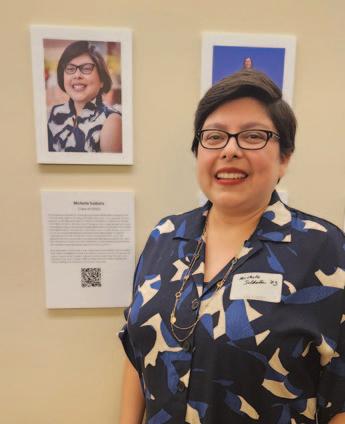
above: OCLAA
Michelle Saldana ’03 talks Salvadoran holiday food traditions in her family. Scan the QR code at right to hear an audio excerpt.

board that the students brought to these interviews is a testament to both professors and the work that they did with them.”
Plans are in motion to create a permanent display dedicated to the project, which will also live online. “Maybe next time it could be the Black Alumni Organization, or the Asian Pacific Islander group,” Cova-Bernal suggests. “It would be everyone’s dream who worked on it to continue it if we can.”
SPRING 2024 OCCIDENTAL MAGAZINE 35
narrator
OXYTALK
left: Student interviewer Hannah Lieberman ’27 with narrator Hector De La Torre ’89. He is the son of Mexican parents who immigrated to America from Jalostotitlán, Jalisco. below: From left, Reception attendees Roxana Castro ’09, Jonathan Santos, Gisselle Cornejo ’08 M’09, OCLAA vice president Virginia Vasquez ’10, and social media chair Karen Oliva ’17.
We Built These Cities
In his first book, city planner and architecture buff Max Podemski ’06 traces
the DNA of urban housing
Growing up in Portland, Ore., Max Podemski ’06 became interested in urban planning at a very early age. “Portland has a reputation for progressive urban planning, and every day I’d read The Oregonian and decided that’s what I wanted to study,” he recalls. “I also wanted to go to a liberal arts college, so Occidental checked those boxes for me.”
During his travels around the country, Podemski—an urban planner for the city of Los Angeles and lifelong architecture buff —came to appreciate the unique housing types that distinguish one city from another. “Boston looks completely different than New York City or Philadelphia, and San Francisco is completely different than L.A.”
For his first book, A Paradise of Small Houses: The Evolution, Devolution, and Potential Rebirth of Urban Housing (Beacon Press), Podemski traces the origins of nine types of housing and the cities where they mostly began, from the row houses of Philadelphia up through the town houses of Houston. “I was looking for housing types that are ubiquitous both in their city and in the region—buildings that were mass produced in one geography during a certain time,” he says.


pleting a master’s in urban planning from Columbia University in between.
In 2018, Podemski joined First 5 LA, one of California’s largest funders of early childhood development. He worked on its Built Environment Policy Advocacy Fund team and created a grant program to aid lowincome communities with applying for and implementing grant money for communitysupporting infrastructure (water, transit, and parks) from local and state agencies.
In his current role as a transportation planner for the L.A. Department of Transportation, Podemski’s projects include working on the Vision Zero program, the city’s commitment to eliminate traffic deaths among pedestrians and cyclists by 2025 through the installation of new traffic signals and crosswalks around the city.
“I walk a lot and have two small kids, so traffic violence is a personal issue to me,” says Podemski, a longtime member of the LADOT Pedestrian Advisory Committee. “Crashes are a leading cause of deaths in Los Angeles. Vision Zero has broader benefits in making our streets more pleasant to walk down and neighborhoods more community-focused.”
A Paradise of Small Houses was a six-year labor of love for Podemski, who also did all the illustrations for the book. As a student at Oxy, he studied abroad in Denmark in an architecture program where we got to sketch building, “so I developed the habit there.”
Others include the New York City tenement, the New Orleans shotgun house, and the Chicago workers cottage. For the bungalow, which actually originated in Southern California, Podemski opted to write about Portland instead “just because I grew up there and I thought I could make that chapter more interesting.”
Of all the structures he discusses, L.A.’s “dingbat” has the least enticing name. “I found this article from a paper in Pomona from the 1950s where a developer was pitching a project to the Pomona City Council and described his housing development as ‘dingbat,’ which is a term for something that’s
shoddily built and thrown up cheap. I don’t know why he used that to describe his own development,” Podemski adds with a laugh.
The term came to be associated with a particular type of apartment structure that sprung up all over Southern California in the post-WWII building boom. “I actually lived in a dingbat in Eagle Rock when I went to Oxy—the Queens Arms at Eagle Rock Boulevard and York,” says Podemski, who lives in Silver Lake (between a duplex and a fourplex). “In films like The Karate Kid and Slums of Beverly Hills, if the character is downwardly mobile, they find themselves in a dingbat.”
After graduating from Oxy, Podemski worked for two years living and working in the East Bay Area as an analyst for the City of Pittsburg Redevelopment Agency. From there, he started the first of two stints with Pacoima Beautiful, an environmental justice nonprofit in the San Fernando Valley, com-
While the book grew out of Podemski’s interest in these different structures, it also dovetails with contemporary themes such as the urban housing crisis. “The United States used to excel at building light-filled, spacious housing for working people, and we have forgotten how to do it,” he says. “I thought this book could also inspire policy change to build more of these types of housing.
“The vast majority of housing in American cities was built by and for working-class people who were often immigrants,” he adds. “The housing they built was ingenious in terms of adapting local cultures and climates and geographies while making houses that in many cases have really stood the test of time.”
In closing, Podemski believes, “We don’t need to invent new cities or new building types. We have the template of how we can build new housing in ways that are in keeping with the traditional fabric of our communities. We just need to make it possible to build like that again.”—dick anderson
64 OCCIDENTAL MAGAZINE SPRING 2024
LAST PAGE
With a first printing of about 12,000, A Paradise of Small Houses was published to wide acclaim in March, including a Publishers Weekly starred review and a favorable notice in The Wall Street Journal
Photo courtesy Max Podemski ’06
Looking for Career Advice? Ask an Oxy GOLD Mentor

Greetings from the Alumni Board of Governors Career and Mentorship Committee! Our committee is dedicated to fostering meaningful connections among alumni and between alumni and students, empowering individuals on their professional journeys. Through a variety of networking events and professional development opportunities, both in-person and virtual, we strive to create a vibrant community that supports career growth and mentorship at Occidental College.

In today’s interconnected world, cultivating relationships is more important than ever. That’s why the Careers and Mentorship Committee is excited to announce the launch of the GOLD Mentorship Project—an initiative aimed at bridging the gap between academic life and the professional world. This pilot program pairs graduates of the last decade (our “GOLD” alumni) with seasoned alumni mentors, providing invaluable guidance and support as they navigate the early stages of their careers.
The GOLD Mentorship Project targets alumni who graduated between 2014 and 2023, connecting them with mentors who can offer insights based on their own educational and professional experiences. By facilitating one-on-one mentorship relationships, we aim to equip
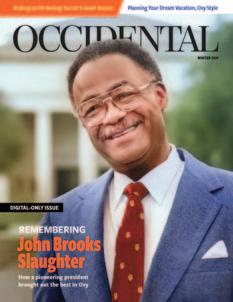
In case you missed it: The life and legacy of President Emeritus John Brooks Slaughter, Oxy’s Sweet 16 men’s soccer team, Minnesota Court of Appeals Judge Keala Ede ’00, and travel mavens Lori Howard ’81, Angelo Carotenuto ’06, and Colleen Robertson ’05 are featured in the Winter 2024 Occidental magazine, which is exclusively online. For all of this and more, visit oxy.edu/magazine.
young professionals with the skills and knowledge needed to thrive in their chosen fields, while also fostering a sense of community within the Occidental College alumni network.
Feedback from the 2023 Alumni Attitude Survey underscores the significance of career readiness and alumni engagement. Mentorship not only benefits individual participants but also strengthens our entire alumni community. As the GOLD Mentorship Project continues to evolve and expand, its impact will be felt far beyond the campus, shaping the future of leadership and innovation.
Whether you’re a recent graduate looking for guidance or a seasoned professional eager to give back, there are countless opportunities to get involved. Keep an eye out for information on how to sign up as a mentor or mentee in the next round of the GOLD Mentorship Project. And don’t forget to connect with us on the official Occidental College Alumni Group on LinkedIn, where you can engage with more than 2,100 fellow alumni and stay updated on upcoming events and initiatives. We look forward to connecting!
Talia Robinson ’97 and Kwame Do ’16 Co-chairs, Careers and Mentorship Committee
Angeles City Council Honors President Elam

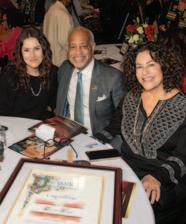
In a February 2 ceremony commemorating the start of African American Heritage Month in Los Angeles, President Harry J. Elam, Jr. was inducted into the city’s African American Hall of Fame and received the Outstanding Achievement in Higher Education Award in recognition of his work at both Occidental College and Stanford University. Above: Elam is pictured with (l-r) Councilmembers Heather Hutt, Marqueece Harris-Dawson, and Curren D. Price Left: Elam was accompanied to the event at Los Angeles City Hall by his wife, Dr. Michele Elam, right, and their daughter, Claire Patterson, left.
Silva Scholarship Turns 30 With Yearlong Endowment Effort
After graduating from Occidental as an economics and Spanish literature double major, José Francisco Silva ’84 was among a core group of alumni “who not only realized Latinos did not have networks in place but did something about it,” Sophia Izquierdo Garbellini ’85 wrote following José’s death in 2008. “He is the reason there is a Latino Alumni Association.”

Created in 1994, Oxy’s Latino/a Scholarship Fund was renamed the José F. Silva ’84 Endowed Memorial Scholarship in 2008 to commemorate his legacy of service. Awarded to a sophomore, junior, and senior each year, Silva Scholars are chosen based on their commitment to social justice, demonstrated leadership, academic excellence, financial need, and involvement in the Latino/a community. Please join us in our effort to raise $400,000 for the Silva Endowed Scholarship Fund by 2025. Your gift will help create life-changing opportunities and make a direct investment in future generations of leaders. For more info, contact Jennifer Conroy at conroyj@oxy.edu or 323-259-1349 or visit oxyoclaa.com/scholarship
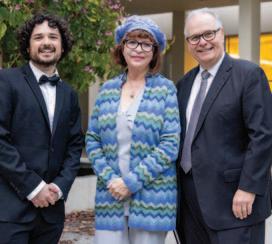
On March 1, Pulitzer Prize-winning Los Angeles Times journalist Patt Morrison ’74 returned to campus for an invigorating conversation with Larry Mantle, host of AirTalk, the longest-running daily talk show in Southern California. Their farranging discussion, co-hosted by the Times and The Occidental newspaper, touched on famous interview subjects, changes in the media landscape, and the importance of storytelling. For the full story, visit oxy.edu/magazine. (Above: The Occidental editor-in-chief Sebastian Lechner ’24, Morrison, and Mantle.)
OXYFARE alumni.oxy.edu
Hats off to Patt!
Photos by Marc Campos (President Elam) and Sarahi Apaez (Patt Morrison)
Los
Office of Communications F-36
1600 Campus Road
Los Angeles CA 90041-3314
Address Service Requested


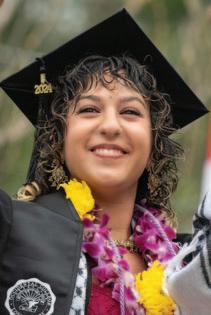
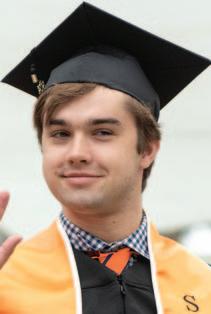
What a Day For Oxy!
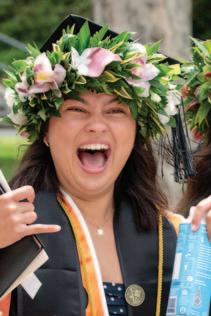

2,640
36giftsin hours
Thank you to everyone who helped make our fifth annual Day For Oxy a success! Tigers from close to home and around the world helped the College surpass its goal on April 18 with a total of 2,177 donors and $1,535,123 raised for Oxy. We are incredibly grateful for this wonderful outpouring of support for our students.
The Oxy Fund raised $663,586!
Including support for financial aid, mental health and wellness, campus sustainability, and programming focused on student belonging
Alumni participation from every class since 1950!
99 student donors
120 faculty and staff donors
Donors came from 49 states! (We’re coming for you next year, West Virginia )
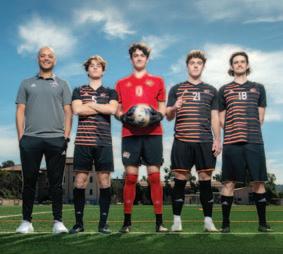

Nonprofit U.S. Postage Paid Occidental College
gift toward Oxy Athletics! #1 by total dollars: Men’s soccer #1 by total donors: Baseball
838 donors made a
39 challenges and matching gifts
From left, Class of 2024 graduates Miriam Aguilar, Kelechi Ogbuokiri, Raina Pahade, Nicholas Novak, and Mia Anzalone. Photos by Marc Campos and John Valenzuela















 The
The



























 Roberta Pollock
Roberta Pollock

 Beth Braker
PROFESSOR OF BIOLOGY
Beth Braker
PROFESSOR OF BIOLOGY



































































